Karl Shuker's Blog, page 11
June 21, 2021
THE DINOSAURS OF CRYSTAL PALACE - VISITING LONDON'S LOST WORLD. Part 2: WELCOME TO THE AGE OF REPTILES!
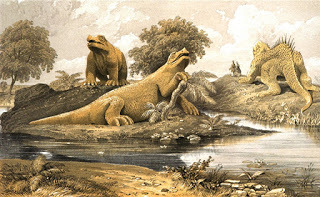 The Crystal Palace dinosaurs, in Views of the Crystal Palace and Park, Sydenham (1854), by Matthew Digby Wyatt with P.H. Delamotte (public domain)
The Crystal Palace dinosaurs, in Views of the Crystal Palace and Park, Sydenham (1854), by Matthew Digby Wyatt with P.H. Delamotte (public domain)
Yesterday, in Part 1 of this 3-part ShukerNature blog article (click hereto access it), we began a virtual, verbal tour of a veritable Lost World in leafy southeast London – Crystal Palace Park's famous Dinosaur Court. It contains a spectacular series of life-sized statues dating back to the 1850s, which had been created by English sculptor and artist Benjamin Waterhouse Hawkins under the supervision of leading British zoologist and palaeontologist Prof. Sir Richard Owen.
They represent no fewer than 20 different species of prehistoric animal, reconstructed with varying degrees of accuracy compared to today's palaeontological counterparts, but still unmatched in terms of artistic magnificence. We have already visited the Court's Cenozoic mammals, but now, here in Part 2, we shall be viewing its most celebrated and stupendous sculptures – a menagerie of reptilian monsters from the Mesozoic Era, the Age of Reptiles, whose most familiar examples are its trio of dinosaur forms.
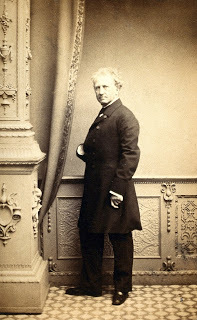 Benjamin Waterhouse Hawkins (Maull & Polyblank Wellcome/Wikipedia –
CC BY 4.0 licence
)
Benjamin Waterhouse Hawkins (Maull & Polyblank Wellcome/Wikipedia –
CC BY 4.0 licence
)
These dinosaurs, all originally known from fossils excavated in England, are represented by a statue of the Jurassic carnivorous theropod Megalosaurus bucklandi, two composite statues of the Jurassic/Cretaceous herbivorous ornithopod Iguanodon (as these were apparently based upon fossil material derived from at least two if not three different iguanodont species), and a statue of the early Cretaceous herbivorous ankylosaur Hylaeosaurus armatus. Whenever anyone talks about Crystal Palace Park's prehistoric animals, it is this exceedingly impressive quartet of stately sculptures that always comes to mind, because they absolutely epitomize the anatomical inaccuracy by present-day standards yet truly iconic, idiosyncratic grandeur of Hawkins's creations. Having said that, the dinosaurs in particular are actually not as inaccurate as they might have been, as will now be explained.
To my mind, the most magnificent of Hawkins's dinosaurs is his enormous Megalosaurus, standing aloof and majestic, the absolute monarch of Secondary Island beyond any shadow of doubt. Yet in morphological terms it resembles an incongruous hybrid of reptile and mammal. For whereas it sports an unequivocally reptilian head, vaguely crocodilian in profile, and its body is covered in scales, it also possesses a muscular, ostensibly mammalian shoulder hump, as well as four vertical, upright limbs, a typically mammalian characteristic. So how can its curiously composite form be explained?
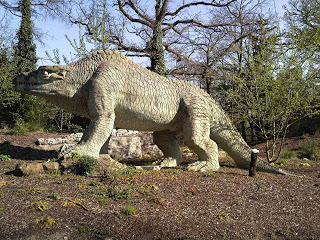 The Crystal Palace Megalosaurus (© Dr Karl Shuker)
The Crystal Palace Megalosaurus (© Dr Karl Shuker)
When in the 1820s dinosaur remains were first scientifically named, described, and recognized to be giant reptiles, some scientists assumed that they were nothing more than gigantic lizards, and illustrations dating from that time period duly depicted them as such. Consequently, had Hawkins heeded those views, he would have reconstructed his dinosaurs not only as quadrupeds (as he did do) but also as ones whose limbs splayed out laterally from their bodies, just like those of lizards do. Fortunately, however, he took his lead from Owen instead, who was convinced that far from simply being enormous lizards, the dinosaurs represented nothing less than the zenith of reptilian development. As a result, in 1841 Owen allocated them to an entirely new taxonomic suborder of reptiles, which he grandly christened Dinosauria ('terrible lizards').
Moreover, based upon his studies of those fossil remains so far disinterred, especially their mighty ribs and limb bones, Owen opined that the dinosaurs' great size would necessarily have incorporated much deeper bodies proportionately speaking than those of lizards, crocodiles, and other present-day reptiles. This in turn would have required their limbs to be sturdier and, crucially, vertical in stance, holding their heavy bodies upright just as the vertical limbs of mammals do.
 My mother Mary Shuker and I with Hawkins's iconic Megalosaurus statue during our visit to Crystal Palace Park's Dinosaur Court on 22 April 2010 (© Dr Karl Shuker)
My mother Mary Shuker and I with Hawkins's iconic Megalosaurus statue during our visit to Crystal Palace Park's Dinosaur Court on 22 April 2010 (© Dr Karl Shuker)
Consequently, when referring to Megalosaurus in his groundbreaking 1841 monograph on British fossil reptiles, Owen confidently stated:
From the size and form of the ribs it is evident that the trunk was broader and deeper in proportion than in modern Saurians, and it was doubtless raised from the ground upon extremities proportionally larger and especially longer, so that the general aspect of the living Megalosaur must have proportionally resembled that of the large terrestrial quadrupeds of the Mammalian class which now tread the earth.
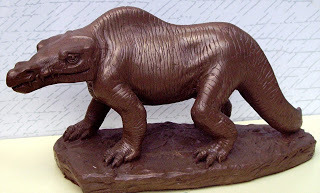 Megalosaurus
model by Benjamin Waterhouse Hawkins, c.1852, Oxford Museum, England (© Ballista/Wikipedia –
CC BY-SA 3.0 licence
)
Megalosaurus
model by Benjamin Waterhouse Hawkins, c.1852, Oxford Museum, England (© Ballista/Wikipedia –
CC BY-SA 3.0 licence
)
It was these comments by Owen that directly influenced Hawkins's designing of Megalosaurus and, to a slightly lesser extent, his other dinosaurs too, as veritable mammalian reptiles, or reptilian mammals, depending upon which taxonomic component of their form any given observer most readily notices. In my case, it was the reptilian head and body scales of Megalosaurusthat first attracted my attention, albeit followed very closely by the surprising realization of just how mammalian its body shape, stature, and stance were – almost like some bizarre coalescence of crocodile and rhinoceros, or alligator and elephant! Indeed, so many people at one time or another have likened this particular statue to a reptilian rhino that I can't help but wonder whether, instead of calling it a dinosaur, we would do better by dubbing it a rhinosaur!
Today, conversely, Megalosaurus is typically reconstructed as a bipedal dinosaur (the concept that some dinosaurs were bipedal was first raised in 1858, too late for Hawkins to utilize it with his creations), possessing longer forearms but otherwise superficially reminiscent of its mighty Cretaceous relative, Tyrannosaurus rex. This is undoubtedly a much more accurate rendition palaeontologically, but is in my opinion a far less memorable, romantic one aesthetically than the Crystal Palace version.
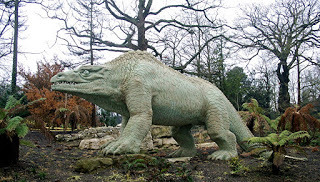 Hawkins's Megalosaurus statue, Crystal Palace (© CGPGrey/Wikipedia –
CC BY-SA 3.0 licence
)
Hawkins's Megalosaurus statue, Crystal Palace (© CGPGrey/Wikipedia –
CC BY-SA 3.0 licence
)
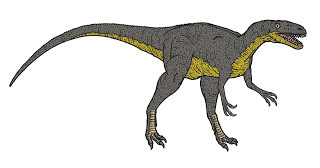 Modern-day reconstruction of Megalosaurus(Conty/Wikipedia – public domain)
Modern-day reconstruction of Megalosaurus(Conty/Wikipedia – public domain)
In the case of the two Iguanodon statues (one constructed standing, the other reposing with one front paw resting indolently upon a reconstructed cycad), their most noticeable feature is the short pointed horn perched somewhat precariously upon the tip of their snout. Yet even Owen was by no means convinced that this structure was valid, expressing his doubts as far back as 1854, which were duly vindicated when further remains and studies revealed that this supposed 'horn' was actually a pointed thumb digit!
Also, once again their quadrupedal stance has since been supplanted, first of all by reconstructions portraying Iguanodon as habitually bipedal, but later still by the currently accepted view that it was both bipedal and quadrupedal, its stance dictated by what it needed to do at any given time.
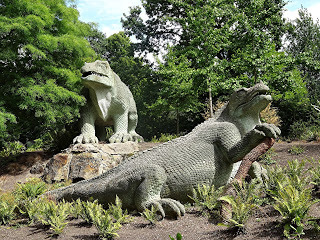 Hawkins's two Crystal Palace Iguanodon statues (© Ian Wright/Wikipedia –
CC BY-SA 2.0 licence
)
Hawkins's two Crystal Palace Iguanodon statues (© Ian Wright/Wikipedia –
CC BY-SA 2.0 licence
)
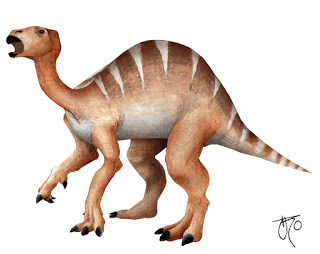 Modern-day reconstruction of Iguanodon (public domain)
Modern-day reconstruction of Iguanodon (public domain)
As for Hylaeosaurus: this is an early Cretaceous ankylosaur, which just for a change is still restored today as a quadruped. Hawkins reconstructed it as a much more lizard-like dinosaur than his quasi-mammalian Megalosaurus statue and his two Iguanodon statues, and he equipped its scaly body with an eyecatching mid-dorsal ridge of long pointed spines running from its neck down the entire length of its back to the end of its long powerful tail.
Even today, little is known of the overall appearance of Hylaeosaurus, because few remains have been uncovered (it is now recognised that Hawkins unknowingly utilized fossils from a wide range of different, but at that time undifferentiated, dinosaurs for inspiration when creating his statue of it). However, some researchers have conjectured that it may have sported not just one but several rows of these spines, bearing them laterally upon its flanks too, not only along its back – more like a reptilian porcupine, in fact, than Hawkins's giant lizard lookalike! Incidentally, its head is a modern fibreglass replica – the original was removed or fell off many years ago (further details concerning it will appear tomorrow in Part 3 of this ShukerNature blog article).
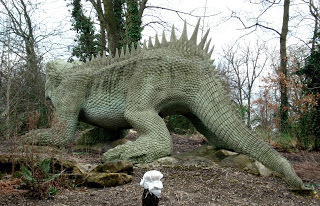 Hawkins's Crystal Palace Hylaeosaurus statue (© Simon/Wikipedia –
CC BY 2.0 licence
)
Hawkins's Crystal Palace Hylaeosaurus statue (© Simon/Wikipedia –
CC BY 2.0 licence
)
 19th-Century engraving based upon Hawkins's Crystal Palace Hylaeosaurusstatue, depicting it looking straight ahead, rather than facing away (the latter being how this statue is positioned in situ) (public domain)
19th-Century engraving based upon Hawkins's Crystal Palace Hylaeosaurusstatue, depicting it looking straight ahead, rather than facing away (the latter being how this statue is positioned in situ) (public domain)
Meanwhile, high upon a fabricated cliff behind the dinosaurs squat a pair of what by today's standards are decidedly strange-looking pterosaurs, with slender toothy jaws but heavily-scaled bodies, membranous bat-like wings that seem oddly oriented, erroneously avian limb posture and body shape, plus long, curved, swan-like necks. Looking up at them, I remember thinking that these winged monstrosities would not look out of place as stony gargoyles perched atop some lofty ledge on the exterior of a gothic cathedral!
The limestone cliff upon which they were originally sited was deliberately blown up during a less-than-successful park modification attempt in the 1960s. However, it was replaced during the extensive restoration work of 2002 by a new cliff, created from Derbyshire limestone, at whose summit these pterosaurs were then duly relocated.
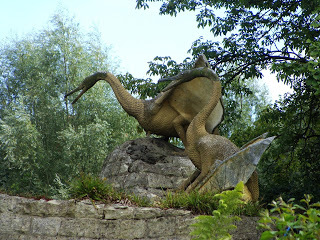 Hawkins's Crystal Palace statues of 'Pterodactylus cuvieri' (© Ben Sutherland/Wikipedia –
CC BY 2.0 licence
)
Hawkins's Crystal Palace statues of 'Pterodactylus cuvieri' (© Ben Sutherland/Wikipedia –
CC BY 2.0 licence
)
In Owen's time, their species was named Pterodactylus cuvieri, but today this is believed to have been based upon remains from more than one species, and they are now deemed to be representatives of the genus Cimoliopterus. The fossils upon which they were based had been derived from British chalk deposits of the Cretaceous Period.
There was once a pair of smaller but extremely elegant pterosaur statues on display here too, perched upon a rock by the teleosaurs (see later), which were notable for their billowing sail-like wings. They were based upon an uncertain species referred to back then as Pterodactylus [later Rhamphocephalus] bucklandi, but they were known colloquially as the Oolite pterosaurs because the fossils upon which they were based had been found in British Oolite rocks, dating from the Jurassic. Tragically, however, as I'll be revealing tomorrow in Part 3, Fate – or, to be more precise, the general public – was less than kind to them.
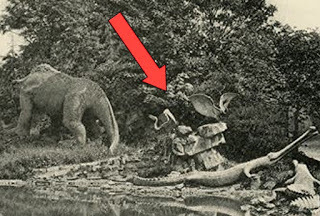 Section from a vintage picture postcard depicting the Crystal Palace Dinosaurs, which includes the two small, now-lost Oolite pterosaurs, arrowed (public domain)
Section from a vintage picture postcard depicting the Crystal Palace Dinosaurs, which includes the two small, now-lost Oolite pterosaurs, arrowed (public domain)
Reposing on Secondary Island's shore and also residing in its offshore waters, as well in as those of Primary Island, are a sundry array of aquatic Mesozoic reptiles. These consist of three plesiosaurs, three ichthyosaurs, and two marine crocodilians, based upon remains originating from such famous English fossiliferous locations as Lyme Regis and Whitby.
There is also a semi-submerged mosasaur, sited apart from the others in a dam setting at the edge of Secondary Island nearest to Tertiary Island, and based upon Dutch fossils.
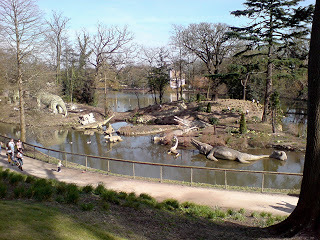 Overview of the Crystal Palace dinosaurs and lake reptiles (© Nick Richards/Wikipedia –
CC BY-SA 2.0 licence
)
Overview of the Crystal Palace dinosaurs and lake reptiles (© Nick Richards/Wikipedia –
CC BY-SA 2.0 licence
)
The three plesiosaurs were reconstructed by Hawkins according to the popular Victorian misapprehension that these water monsters' elongate necks were inordinately flexible, virtually able to tie themselves in knots, in stark contrast to modern-day views that they were in fact relatively inflexible, stretching forward in a fairly stiff horizontal manner. Their bodies are also more slender and supple than is nowadays believed for such reptiles.
Each plesiosaur statue represents a different species. Namely, Plesiosaurus dolichodeirus, "P." [=Rhomaleosaurus?] macrocephalus, and Thalassiodracon hawkinsi. However, there is some modern-day disagreement as to which statue represents which species.
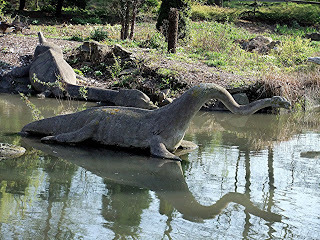

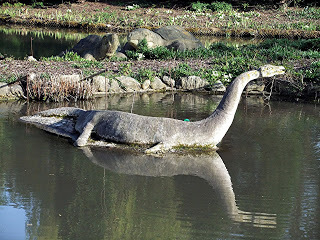 Hawkins's three Crystal Palace plesiosaur statues (© Dr Karl Shuker)
Hawkins's three Crystal Palace plesiosaur statues (© Dr Karl Shuker)
Hawkins's trio of ichthyosaurs (again each one representing a different species) look distinctly odd too, due in no small way to their conspicuous lack of both a dorsal fin and the very large vertical shark-like tail fin that all but the earliest of these marine reptiles are now known to have possessed. Instead, Hawkins simply gave them long flat tails emerging directly from their backbone (plus a small flat terminal protuberance for the biggest ichthyosaur's tail), and he positioned these creatures resting partly out of the water on the island's shore, more like seals than sea reptiles.
In addition, their large eyes are encircled with exposed bony sclerotic plates, which are indeed present in fossil ichthyosaur remains but were much more likely to have been hidden beneath skin in the living animals (as they are in various modern-day creatures that possess them). The three species represented are Temnodontosaurus platydon (the largest member of this trio), Ichthyosaurus communis (the mid-sized one), and Leptonectes tenuirostris (the smallest).
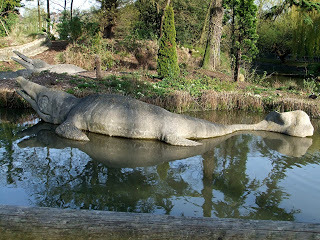 Two of Hawkins's three Crystal Palace ichthyosaur statues – Temnodontosaurus platydon in foreground, with the head of Leptonectes tenuirostris visible in background (© Dr Karl Shuker)
Two of Hawkins's three Crystal Palace ichthyosaur statues – Temnodontosaurus platydon in foreground, with the head of Leptonectes tenuirostris visible in background (© Dr Karl Shuker)
 Two of Hawkins's three Crystal Palace ichthyosaur statues – Leptonectes tenuirostris at back, Ichthyosaurus communis in front (© Dr Karl Shuker)
Two of Hawkins's three Crystal Palace ichthyosaur statues – Leptonectes tenuirostris at back, Ichthyosaurus communis in front (© Dr Karl Shuker)
Two marine crocodilians, Teleosaurus, are also present, sporting very long, slender gharial-like jaws, elongate bodies, long tails, and clawed shortish limbs, which is how this prehistoric oceanic reptile is still restored today. Unfortunately, their scales are visibly based upon those of modern-day crocodiles rather than fossil teleosaurs.
Teleosaurs belong to the now-extinct suborder of crocodilians known as thalattosuchians. Some of its members included fully aquatic species whose limbs had evolved into paddle-shaped flippers, unlike the clawed limbs of teleosaurs.
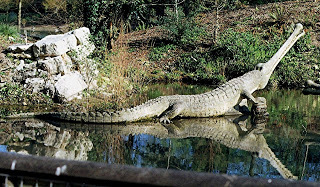
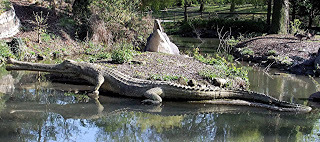 Hawkins's two Crystal Palace Teleosaurusstatues (© Dr Karl Shuker)
Hawkins's two Crystal Palace Teleosaurusstatues (© Dr Karl Shuker)
As for the mosasaur: at the time of Hawkins's statue, only the appearance of these varanid-related aquatic lizards' head was known. So, supplemented merely by a generic scaly upper back portion and a single forelimb, this is all that Hawkins created, skilfully positioning this very incomplete statue so as to create the illusion that its largely non-existent body was actually present but submerged beneath the water surface!
Having said that, Hawkins was more than happy to improvise then-undescribed body portions for various other creatures here, including the dinosaur Hylaeosaurusand the therapsid Dicynodon (see later). Hence it seems odd that he didn't do the same for this mosasaur. Its species is Mosasaurus hoffmanni.
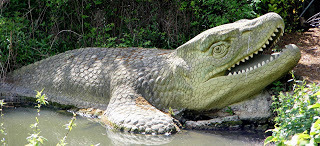 Hawkins's Crystal Palace Mosasaurus statue (© Andrew Wilkinson/Wikipedia –
CC BY-SA 2.0 licence
)
Hawkins's Crystal Palace Mosasaurus statue (© Andrew Wilkinson/Wikipedia –
CC BY-SA 2.0 licence
)
 Modern-day reconstruction of Mosasaurus (Dimitry Bogdanov/Wikipedia
– public domain)
Modern-day reconstruction of Mosasaurus (Dimitry Bogdanov/Wikipedia
– public domain)
Continuing along Dinosaur Court's mainland footpath that leads past each of the islands and takes the visitor ever further back in geological time, the Mesozoic's giant reptilian mega-stars of land, air, and water that are present on and around Secondary Island are now left behind, and five statues of smaller, less familiar archaic herpetological creatures are encountered on Primary Island, near the water edge.
Three of these are prehistoric amphibians, specifically temnospondyls – a diverse, long-extinct taxonomic group that includes various amphibians formerly categorized as either labyrinthodonts or stegocephalians. Moreover, unlike any amphibians alive today, some temnospondyls were scaly-skinned, like reptiles; others, conversely, were smooth-skinned, like modern-day amphibians.
 19th-Century drawing of Hawkins's Crystal Palace statue of Mastodonsaurus jaegeri, aka Labyrinthodon salamandroides, a temnospondyl (public domain)
19th-Century drawing of Hawkins's Crystal Palace statue of Mastodonsaurus jaegeri, aka Labyrinthodon salamandroides, a temnospondyl (public domain)
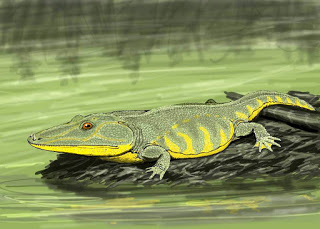 Modern-day reconstruction of Mastodonsaurus (public domain)
Modern-day reconstruction of Mastodonsaurus (public domain)
The largest temnospondyl species could attain lengths of up to 20 ft, i.e. far bigger than any modern-day amphibian. Moreover, we know today from abundant fossil evidence that they were long-jawed, long-tailed, lengthy-bodied beasts, superficially resembling crocodiles, with smaller ones resembling salamanders.
Back in the days of Owen and Hawkins, conversely, with far fewer uncovered fossils available for study, it was wrongly assumed that they simply looked like very large frogs. Hence this is how Hawkins reconstructed the bodies of the two temnospondyl species on display here in Dinosaur Court, adding only short stumpy tails, although he did provide their heads with longer jaws than those of frogs.
 Hawkins's Crystal Palace statue of Mastodonsaurus jaegeri, aka Labyrinthodon salamandroides (© Dr Karl Shuker)
Hawkins's Crystal Palace statue of Mastodonsaurus jaegeri, aka Labyrinthodon salamandroides (© Dr Karl Shuker)
One of these species, represented by a single large statue, was known back then as Labyrinthodon salamandroides, but was subsequently renamed during various reclassifications, and is currently referred to as Mastodonsaurus jaegeri. Hawkins reconstructed it with smooth skin. It lived in what is today Europe, including the UK, during the early Mesozoic's mid-Triassic Period, 247-237 million years ago, and is nowadays believed to have been predominantly aquatic, rarely leaving the water, whereas Hawkins positioned his statue of it on land. The biggest specimens were up to 20 ft long.
The other species, represented by a couple of smaller statues, was known in Hawkins's time as Labyrinthodon pachygnathus, but today is called Cyclotosaurus pachygnathus. This was a temnospondyl with scaly skin, which Hawkins duly incorporated into his reconstruction, but otherwise his statue of it looks very similar to his Mastodonsaurus specimens, i.e. frog-like but with fairly long jaws. It existed from the mid to late Triassic Period, which ended around 200 million years ago, grew up to 14 ft long, and lived in Europe, especially in what is now Germany.

 Hawkins's two Crystal Palace statues of Cyclotosaurus pachygnathus aka Labyrinthodon pachygnathus (© Dr Karl Shuker)
Hawkins's two Crystal Palace statues of Cyclotosaurus pachygnathus aka Labyrinthodon pachygnathus (© Dr Karl Shuker)
The final two statues displayed on Dinosaur Park's Primary Island, one somewhat larger than the other, represent a strange creature known as Dicynodon, which existed in what is now South Africa, and dates further back in time than any other animal form represented here. Flourishing during the upper Permian Period of the late Palaeozoic Era, approximately 252 million years ago (certain Triassic species have also been described but these are all nowadays reclassified in other genera), Dicynodon was a therapsid, That is, it belonged to a reptilian group commonly dubbed the mammal-like reptiles, because this was the group that did indeed give rise to the mammals, evolving certain anatomical features that would characterize the mammals once the therapsids themselves died out.
Unfortunately, however, back in Hawkins's day, this reptile was principally known only from skulls, which were characterized by a pair of sizeable upper tusks and a horny tortoise-like beak. Consequently, adhering to Owen's conjecture that its body may have borne a shell, Hawkins accordingly reconstructed Dicynodonas a veritable sabre-toothed tortoise, and sporting not only a domed chelonian carapace but also a scute-bearing tail reminiscent of the American snapping turtle's. This is of course all dramatically different from the shell-less, barrel-bodied, mammalian predecessor that we now know this reptile to have been. Herbivorous by nature, Dicynodonis believed to have used its two large upper tusks (which were its only teeth) for digging up roots and tubers, whereas its beak was probably used for cropping vegetation.
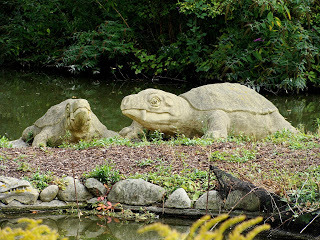 Hawkins's two Crystal Palace Dicynodon statues (© Ben Sutherland/Wikipedia –
CC BY 2.0 licence
)
Hawkins's two Crystal Palace Dicynodon statues (© Ben Sutherland/Wikipedia –
CC BY 2.0 licence
)
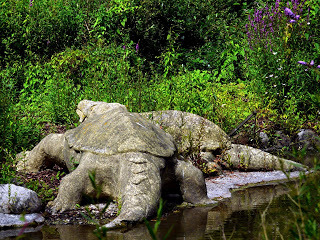 Rear view of Hawkins's two Crystal Palace Dicynodon statues, showing their tail scutes (© Loz Pycock/Wikipedia –
CC BY-SA 2.0 licence
)
Rear view of Hawkins's two Crystal Palace Dicynodon statues, showing their tail scutes (© Loz Pycock/Wikipedia –
CC BY-SA 2.0 licence
)
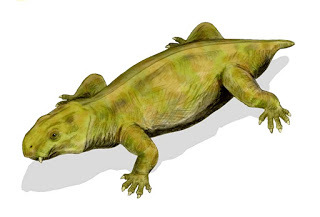 Modern-day reconstruction of Dicynodon (Nobu Tamura/Wikipedia –
CC BY 2.5 licence
)
Modern-day reconstruction of Dicynodon (Nobu Tamura/Wikipedia –
CC BY 2.5 licence
)
Continuing along the mainland footpath leads round to the opposite side of the islands, which afforded a clearer view of the pterosaurs and the giant ground sloth when I visited in 2010, before finally ending full circle back at the entrance.
Unexpectedly, just before the entrance is reached, a statue of London Zoo's famous former resident Guy the Gorilla is encountered – offering some great opportunities for selfies!
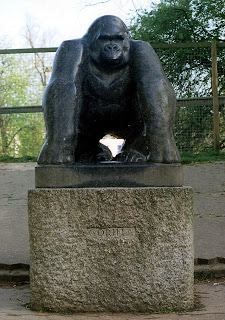 The statue of London Zoo's Guy the Gorilla in Crystal Palace Park (© Dr Karl Shuker)
The statue of London Zoo's Guy the Gorilla in Crystal Palace Park (© Dr Karl Shuker)
Having now completed our virtual tour of Crystal Palace's Dinosaur Court, tomorrow, in Part 3 of this ShukerNature blog article, its spectacular exhibits' continual battle against the ravages of time, not to mention wanton vandalism, will be revealed.
We shall also look further afield, to discover what would have – should have – been Hawkins's supreme, transatlantic triumph. But as will be seen, Fate – and inhuman humanity – had other ideas. Don't miss it! And be sure to click hereto read Part 1, posted on ShukerNature by me yesterday.
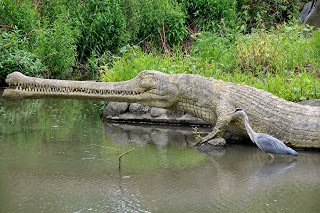 One of Hawkins's Crystal Palace Teleosaurusstatues alongside a very much alive grey heron! (© Chris Sampson/Wikipedia –
CC BY 2.0 licence
)
One of Hawkins's Crystal Palace Teleosaurusstatues alongside a very much alive grey heron! (© Chris Sampson/Wikipedia –
CC BY 2.0 licence
)
June 19, 2021
THE DINOSAURS OF CRYSTAL PALACE - VISITING LONDON'S LOST WORLD. Part 1: MEGALOSAURUS, MEGALOCEROS, MEGATHERIUM, AND MORE!
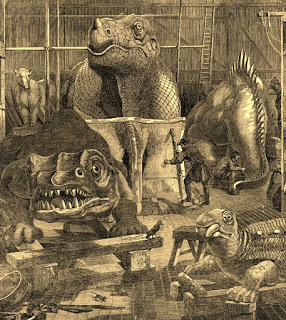 Benjamin Waterhouse Hawkins's Crystal Palace studio in 1853, containing some of his completed statues of prehistoric 'monsters' (public domain)
Benjamin Waterhouse Hawkins's Crystal Palace studio in 1853, containing some of his completed statues of prehistoric 'monsters' (public domain)
On 22 April 2010, I finally fulfilled a lifelong ambition, by visiting a veritable Lost World of dinosaurs and other monstrous members of our planet's prehistoric fauna. Yet this particular Lost World was located not atop some lofty South American mesa, or concealed amid some remote African rainforest. Instead, it was cosily ensconced within a leafy, tranquil setting not very far from the frantic hustle and bustle of central London. I refer of course to Crystal Palace Park, and its spectacular array of life-sized (albeit far from life-like) palaeontological reconstructions, which date back to Victorian times and include the earliest representations of dinosaurs ever created.
Today, they are considered by many to be nothing more than antiquated curiosities, at least as far as their direct relevance to modern-day fossil studies is concerned. Yet in historical terms, their significance is immense, as is their aesthetic value as stunning works of art. So here via this comprehensive 3-part ShukerNature blog article, I invite you all to pay a virtual, verbal visit with me to these extraordinary creations, and uncover their fascinating histories and mysteries.
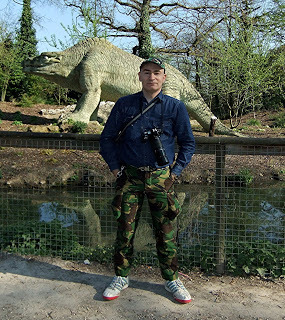 Standing in front of the iconic Megalosaurus statue in the Dinosaur Court at Crystal Palace Park, London, on 22 April 2010 (© Dr Karl Shuker)
Standing in front of the iconic Megalosaurus statue in the Dinosaur Court at Crystal Palace Park, London, on 22 April 2010 (© Dr Karl Shuker)
I first learnt of the Crystal Palace dinosaurs from one particular animal book that (along with many others) my mother had bought me when I was a child, back in the 1960s. A compilation of chapters written by several different authors, and which I still own today as a fond reminder of my early years, it was entitled Children's Encyclopedia of Knowledge: Book of Nature, and had been published by Collins in 1967. I'd also been bought a number of books devoted specifically to dinosaurs and other prehistoric beasts. Yet whereas the respective reconstructions in these latter books of the various famous dinosaurs' likely appearance in life all compared well with one another, those in my Book of Nature were radically different. This notable discrepancy puzzled me for some time until I finally uncovered the answer.
The dinosaur illustrations in the above-named book were photographs of enormous statues on display in southeast London's Crystal Palace Park, but they more closely resembled giant, misshapen lizards than the very distinctive, familiar forms depicted in all of my dinosaur books. Back in those far-distant pre-internet times, it took a while for me to learn more about them, but during the mid-1970s I bought Adrian J. Desmond's bestselling book The Hot-Blooded Dinosaurs (1975), which included a fascinating history of how and when the first dinosaur remains had been discovered, and it was here that the secret of Crystal Palace Park's mystifying monsters was at last revealed to me.
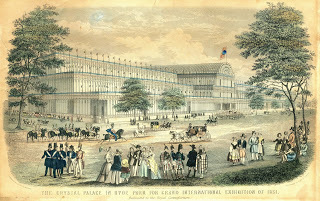 Vintage engraving of the Crystal Palace in Hyde Park, London, for the Great Exhibition, 1851 (public domain)
Vintage engraving of the Crystal Palace in Hyde Park, London, for the Great Exhibition, 1851 (public domain)
The year 1851 saw Central London's Hyde Park host the world-famous Great Exhibition (1 May-15 October), which was a huge exposition showcasing the finest achievements of British industry as well as including displays from other countries around the world too. It was housed within a spectacular, palatial exhibition centre designed by Sir Joseph Paxton and composed extensively of glass, which duly became known as the Crystal Palace. Although initially intended to be merely a temporary creation, so popular did this very imposing, impressive edifice prove to be that when the Great Exhibition ended, instead of being demolished the Crystal Palace was purchased for £50,000 by the new, specially-created Crystal Palace Company, which then paid for it to be dismantled and moved in its entirety from Hyde Park to Penge, situated on the lower slopes of Sydenham Hill, southeast London.
Here it was painstakingly reassembled and became the focus of a new, specially-designed park, with beautiful landscaped gardens, lakes, statues, and many other eyecatching features. These included what became its most famous attractions – the incredible statues of huge dinosaurs and other exotic-looking prehistoric animals created by English sculptor and artist Benjamin Waterhouse Hawkins (1807-1894).
 Benjamin Waterhouse Hawkins sitting (Maull & Polyblank Wellcome/Wikipedia –
CC BY 4.0 licence
)
Benjamin Waterhouse Hawkins sitting (Maull & Polyblank Wellcome/Wikipedia –
CC BY 4.0 licence
)
Despite having become extinct many millions of years ago, dinosaurs are among the most popular of all animals in today's world, their diverse imagery appearing everywhere, from books and films to toys and postage stamps, as well as being represented by countless displays in museums worldwide. All of which makes it all the more surprising, therefore, that although dinosaur fossils had been dug up by geologists and excavators for centuries, it was not until 1824 when the first dinosaur was scientifically named.
This was the 25-30-ft-long carnivorous theropod Megalosaurus ('big lizard'), a saurischian or lizard-hipped dinosaur, by Oxford University's Professor of Mineralogy and Geology, the Reverend William Buckland, based upon fossil remains unearthed in Oxfordshire, and originally thought to indicate a creature measuring around 40 ft long. A year later saw the naming of a second dinosaur form, the herbivorous 30-40-ft ornithopod Iguanodon, based upon remains found in the Tilgate Forest area of West Sussex by English palaeontologist Gideon Mantell and initially deemed by him to have measured around 60 ft long. This was followed in 1833 by a third, Hylaeosaurus, a herbivorous spiny ankylosaur, originally thought to have been approximately 25 ft long but nowadays downsized to around 10-13 ft. Its remains had been exposed after an explosion had demolished a quarry face not far from where Mantell's Iguanodon remains had been obtained. Both of these latter forms are ornithischian or bird-hipped dinosaurs, and both were named by Mantell.
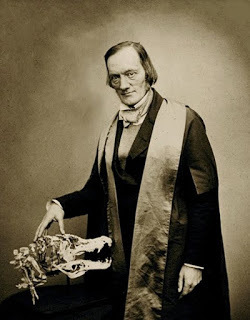 Professor Sir Richard Owen (public domain)
Professor Sir Richard Owen (public domain)
When ideas were being sought for subjects to be represented in the new Crystal Palace Park, the suggestion of constructing life-sized representations of extinct animals was put forward, although there is still some controversy as to its originator. However, Queen Victoria's enterprising consort Prince Albert (already responsible for the Great Exhibition itself), Britain's foremost zoologist and palaeontologist of the day, Prof. Sir Richard Owen (1804-1892), and the Crystal Palace's designer, Sir Joseph Paxton, were all probably involved. Once this notion had been formally accepted, in September 1852, Hawkins was duly commissioned by the Crystal Palace Company to construct these statues, using concrete, brick, lead, and steel.
Initially, the plan was to concentrate upon prehistoric mammals, with thoughts of reconstructing mastodonts, mammoths, and other furry wonders from the distant past. But once Hawkins had read some of Owen's publications, it wasn't long before the prospect of also reconstructing dinosaurs reared its reptilian head. At that time, only the above-named trio of dinosaurs had been formally recognized, so Hawkins decided to recreate all three of them with life-sized sculptures to show what they may have looked like in life. Moreover, as his work progressed, the scheme was expanded still further to include reconstructions of quite a number of other archaic beasts too.
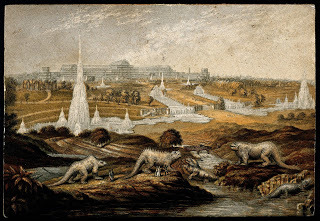 'The 'Crystal Palace' from The Great Exhibition', an engraving by George Baxter, after 1854 (Wellcome Images-Wikipedia –
CC BY4.0 licence
)
'The 'Crystal Palace' from The Great Exhibition', an engraving by George Baxter, after 1854 (Wellcome Images-Wikipedia –
CC BY4.0 licence
)
Indeed, by the end of the project, no fewer than 33 statues representing 20 different animal species had been produced (together with some reconstructions of fossil plants too, such as cycads), yielding a major attraction dubbed Dinosaur Court (aka Dinosaur Park), which encompassed three specially-created islands within a large artificial lake, situated near the southern end of Crystal Palace Park itself. Although the idea was to focus upon such creatures that had once existed in Britain, some non-native examples were also represented, Hawkins having utilised fossil remains from Holland when reconstructing the mosasaur, for instance, from South Africa for Dicynodon, and from South America for Megatherium.
This unique project was nearing completion by the end of 1853, so to mark with suitable panache its impending official opening, a lavish banquet given by Hawkins was held on 31 December, New Year's Eve, of that same year, at which 21 notable dignitaries invited by him attended, including Owen and world-renowned bird painter John Gould. And the setting for this celebration? None other than inside Hawkins's colossal hollow mould for the construction of his standing Iguanodon statue! Never before, and probably never again, would such an event take place quite literally inside the bowels of a Mesozoic mega-beast!
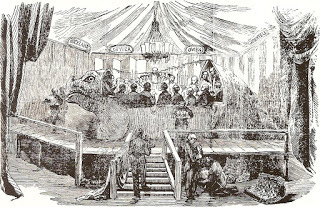 Banquet inside the mould of Hawkins's Crystal Palace Iguanodon statue, New Year's Eve 1853 (public domain)
Banquet inside the mould of Hawkins's Crystal Palace Iguanodon statue, New Year's Eve 1853 (public domain)
Just over 5 months later, on 10 June 1854, Crystal Palace Park was formally opened by Queen Victoria and Prince Albert. Furthermore, no fewer than 40,000 visitors were in attendance, anxious to see what the media were enthusiastically referring to as an incredible assemblage of antediluvian monsters, i.e. labeling them as giant creatures that were believed by Creationists and other religious figures from that time to have existed on Earth during its earliest age before being wiped out by the Great Flood.
Although initially proving very popular, the Crystal Palace Park's Dinosaur Court eventually fell out of favour, especially once continuing palaeontological discoveries revealed that most of its reconstructions were actually very inaccurate. Neglected, especially after the Crystal Palace's destruction by fire in 1936, the statues eventually became partially hidden amid an overgrowth of undergrowth, and suffered considerably from damage caused not only by external, environmental influences but also by vandalism. Happily, following a first major restoration project in 1952, the historical significance of Hawkins's creations as a pioneering palaeontological venture was belatedly recognized, and in 1973 they were officially classed as National Heritage Grade II Listed Monuments, upgraded to Grade I in 2007. Meanwhile, an extensive second restoration project had taken place in 2002, recreating their dignified former appearance, making many repairs to their crumbling forms, and overseen by the London Borough of Bromley, the landowner of Crystal Palace Park.
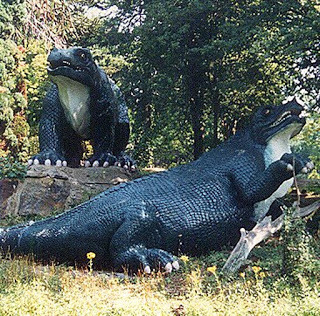 Indigo Iguanodons in 1995, before the 2002 restoration, showing their previous countershaded paint scheme with white undersides (public domain)
Indigo Iguanodons in 1995, before the 2002 restoration, showing their previous countershaded paint scheme with white undersides (public domain)
Intriguingly, I'd long heard rumours that during the 1970s and possibly beyond, some of these statues were painted in bright garish colours. Only recently, however, have I uncovered some notable details concerning this hitherto scarcely-documented chapter in their long-running saga.
For example: during their 'painted period', the standing Iguanodonstatue was initially rendered a deep olive green with contrasting white underparts and golden jaw edges, but by the late 1970s both Iguanodon statues were dark indigo blue dorsally, pure white ventrally (although their throat region began as a flushed pink shade, subsequently fading to white). They still sported this colour scheme during the 1990s (as confirmed by some early 1990s videos and mid-1990s photos of them), whereas in still later photos they are a pale mint green. In addition, Mandy Holloway, Curator of Fossil Reptiles, Amphibians, and Birds at London's Natural History Museum at that time, has shown me a photograph snapped by her of the left-hand side of the Megalosaurus(nowadays uniformly grey all over) that reveals the presence of a thick red horizontal stripe running along its lower flank, and striations of the same shade upon its limbs.
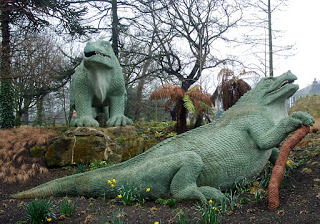 Crystal Palace's Iguanodons when mint-green in colour (© CGPGrey/Wikipedia –
CC BY 2.0 licence
)
Crystal Palace's Iguanodons when mint-green in colour (© CGPGrey/Wikipedia –
CC BY 2.0 licence
)
Moreover, the charity organization Friends of Crystal Palace Dinosaurs (FOCPD – click here to access their fascinating and very worthy website) kindly alerted me to a music video from 1977 currently accessible online (click hereto view it) that features the late singer Lena Zavaroni boating past these dinosaur statues while singing the song 'I Had A Brontosaurus', in which the Megalosaurus is almost entirely bright red. I'd initially assumed that this vivid colouration was simply a special-effect created for the video, but Mandy confirmed that it was genuine – the Megalosaurus having been painted red on the instructions of the now long-defunct Greater London Council (GLC), which was also responsible for painting the other statues in Dinosaur Court that were brightly coloured during that period. Apparently, the reason for doing so was to make the statues appealing to young visitors, as a children's zoo had also been set up there, on Tertiary Island.
Correspondent Sam Crehan has shown me a full-colour photo of the Megalosaurusstatue during its red phase that appears in the little children's book I-Spy Dinosaurs and Prehistoric Animals, and which reveals that its underparts (not very visible in the Lena Zavaroni music video) were white. (I suspect that the statue's red colour in the video, so bright that it virtually glows, has been enhanced, to make it more visible against its dark, shadowy background.)
 From I-Spy Dinosaurs and Prehistoric Animals as scanned by Sam Crehan, a full-colour photo of the Megalosaurus statue during its red phase (© Faber & Faber/I-Spy Ltd/Michelin – reproduced here on a strictly non-commercial Fair Use basis for educational/review purposes only)
From I-Spy Dinosaurs and Prehistoric Animals as scanned by Sam Crehan, a full-colour photo of the Megalosaurus statue during its red phase (© Faber & Faber/I-Spy Ltd/Michelin – reproduced here on a strictly non-commercial Fair Use basis for educational/review purposes only)
In January 2021, Crystal Palace Dinosaurs devotee Anthony Hawkins posted on FOCPD's Facebook page a photo of the Megalosaurus when red with white underparts that dated from December 1980. And a similar photo from 1979 was an entry in the 2016 Arles Festival of Photography, Rencontre d'Arles, a premier event for photographic art.
Finally, Canadian cryptozoological friend Sebastian Wang has drawn my attention to the official website of Palaeoplushies, a manufacturer of plush toys, which includes in its list of products not one but two versions of the Crystal Palace Megalosaurus– identical in shape and size, but very different in colour. For whereas one is grey, the other is red. In its official description of these two Megalosaurus versions, Palaeoplushies refers to the grey one as ""Classic Grey" – The current weathered grey concrete look", and to the red one as ""70s red" – The look this statue had during the 70s" (click hereto view and/or purchase these Megalosaurusplushies on the Palaeoplushies website). In short, Megalosaurus really was red in colour during the 1970s and at least as recently as the early 1980s too. This in turn means that Mandy's photo of it sporting just a horizontal red flank stripe and some red leg markings was snapped at a time when most of its red paint had been removed or painted over, or had simply faded away (red and yellow pigments are very prone to fading when exposed to sunlight).
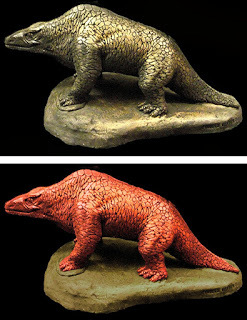 My resin model of the Crystal Palace Megalosaurusstatue – my model's original golden-scaled form (top) and digitally recoloured to show what the statue would have looked like during its red-painted period (bottom) (© Dr Karl Shuker)
My resin model of the Crystal Palace Megalosaurusstatue – my model's original golden-scaled form (top) and digitally recoloured to show what the statue would have looked like during its red-painted period (bottom) (© Dr Karl Shuker)
Dinosaur Court's prehistoric creatures were originally located upon, and also within the waters surrounding, three artificial islands (named Tertiary, Secondary, and Primary), and most of these statues are still there today. The general public can walk around the islands (but not as yet directly upon them, except during special annual Open Days) via a railed public footpath on the Court's mainland portion, which affords excellent views of all of the statues. The islands are arranged in geological order, with their respective creatures dating from the Cenozoic Era back as far as the Permian Period of the late Palaeozoic Era. However, the Mesozoic Era is the Court's principal focus, because that is when most of the archaic beasts represented here existed, during the Age of Reptiles, as this era is commonly termed.
After arriving inside Crystal Palace Park's Dinosaur Court, if we begin our journey through geological time with the most recent creatures represented here, as I did, the first of Hawkins's statues encountered are four different mammals from the Cenozoic Era. These were formerly present on Tertiary Island, but except for the ground sloth they have now been relocated on the nearby mainland.
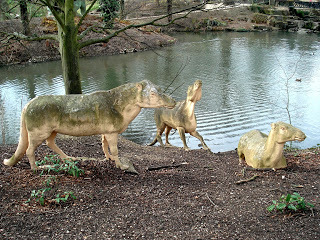 Anoplotherium
herd in Crystal Palace Park's Dinosaur Court (© Simon/Wikipedia –
CC BY 2.0 licence
)
Anoplotherium
herd in Crystal Palace Park's Dinosaur Court (© Simon/Wikipedia –
CC BY 2.0 licence
)
One of these mammals is Anoplotherium, represented by a small herd of three statues when I visited and photographed them in 2010 (yet some sources claim that only two exist). It was a primitive artiodactyl ungulate (even-toed hoofed mammal) from the late Eocene and early Oligocene Epochs (c.37-33 million years ago).
Anoplotherium is nowadays thought to be related to camels and llamas, and which Hawkins did provide with a camel-like head and neck. Its fossil remains have been found widely across Europe, including Hampshire and the Isle of Wight in the UK.
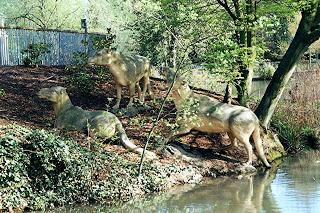 Anoplotherium herd seen from the opposite side, Crystal Palace (© Dr Karl Shuker)
Anoplotherium herd seen from the opposite side, Crystal Palace (© Dr Karl Shuker) Also represented here is Palaeotherium, another primitive hoofed mammal, in existence at much the same time as Anoplotherium and whose remains have again been found in Hampshire and the Isle of Wight. Unlike Anoplotherium, however, Palaeotherium was a perissodactyl (odd-toed) ungulate. Originally there were three statues of it, but the largest one mysteriously vanished sometime after the late 1950s and has never been seen again.
Hawkins followed the opinion of eminent French zoologist Baron Georges Cuvier concerning the likely appearance of Palaeotherium in life, reconstructing it to resemble those modern-day perissodactyls the tapirs. Today, conversely, palaeontologists generally depict it as a perissodactylian parallel to the artiodactylian giraffe's shorter-necked forest relative, the okapi.
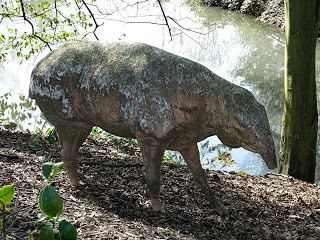 One of Hawkins's Crystal Palace Palaeotheriumstatues (© Dr Karl Shuker)
One of Hawkins's Crystal Palace Palaeotheriumstatues (© Dr Karl Shuker)
My favourite Hawkins mammals are his very imposing giant deer or Irish elks Megaloceros giganteus, consisting of two antlered adult stags standing regally and an antler-lacking adult doe reposing with her fawn close by. Even today, these statues still correspond well with palaeontological thoughts regarding their likely appearance. This is because Hawkins based them upon living modern-day deer.
In addition, for his stag statues' antlers he utilized actual complete fossils of the famously magnificent antlers borne by this species' stags, but in subsequent years these real fossil antlers were replaced by replicas. Their remains have been found not only in Ireland but also on the Eurasian mainland, including as far east as Siberian Russia. Some have been dated to as recently as the early Holocene, 8000 years ago.
 Giant deer aka Irish elks Megaloceros giganteusat Crystal Palace Park (© Neil Cummings/Wikipedia –
CC BY-SA 2.0 licence
)
Giant deer aka Irish elks Megaloceros giganteusat Crystal Palace Park (© Neil Cummings/Wikipedia –
CC BY-SA 2.0 licence
)
Finally, a suitably huge Pliocene/Pleistocene Megatherium or giant ground sloth from Argentina squats upright on its haunches, grasping a tall tree. However, it sports a short trunk-like proboscis that is no longer thought to have been a valid feature of this creature.
Over the course of many years following the sloth's installation at Dinosaur Court in 1854, the girth of the tree that it is grasping grew so wide that it broke the sloth's left forearm, which needed to be restored. And at the time of my visit in 2010, its right paw was missing.
 Front and side views of the Megatheriumstatue in 2010, clearly revealing that its right front paw was missing at that time (© Dr Karl Shuker)
Front and side views of the Megatheriumstatue in 2010, clearly revealing that its right front paw was missing at that time (© Dr Karl Shuker)
Also worth noting is that at one stage during its long and distinguished existence, this very spectacular statue shared its location with the afore-mentioned children's zoo. That must surely be the only example of such a zoo to contain a giant ground sloth in its midst!
Moreover, although this Crystal Palace example is the first Megatheriumstatue to have been attempted by Hawkins, in subsequent years its gigantic species would again be an inspiration to him when designing a second major exhibit, as will be revealed later here.
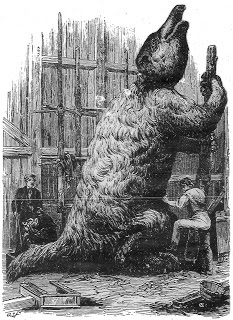 19th-Century engraving of the Crystal Palace Megatherium, depicting it when its right front paw was still intact (public domain)
19th-Century engraving of the Crystal Palace Megatherium, depicting it when its right front paw was still intact (public domain)
Memorable though these bygone mammals are, it will come as no surprise to learn, however, that the most popular portion of Dinosaur Court is the next island to which the mainland public footpath now leads, Secondary Island. For this contains Hawkins's most famous creations – his Mesozoic dinosaurs and pterosaurs. Moreover, on its shore and also in the adjacent waters of Dinosaur Court's lake are Mesozoic plesiosaurs, ichthyosaurs, sea crocodilians, and a mosasaur.
So that is where our virtual tour of Crystal Palace's Lost World will be taking us tomorrow, in Part 2 of this ShukerNature blog article – back in time to the astonishing Age of Reptiles. Don't miss it!
 My mother Mary Shuker and the Megatheriumstatue at Crystal Palace Park on 22 April 2010 (© Dr Karl Shuker)
My mother Mary Shuker and the Megatheriumstatue at Crystal Palace Park on 22 April 2010 (© Dr Karl Shuker)
June 17, 2021
WAS A POTENTIAL SOURCE OF NESSIE DNA PROPELLED INTO OBLIVION?
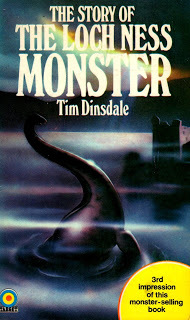 The Story of the Loch Ness Monster
(1973), by Tim Dinsdale – the very first book devoted entirely to Nessie that I ever read and owned – and I still own it today (© Tim Dinsdale/Target Publishers – reproduced here on a strictly non-commercial Fair Use basis for educational/review purposes only)
The Story of the Loch Ness Monster
(1973), by Tim Dinsdale – the very first book devoted entirely to Nessie that I ever read and owned – and I still own it today (© Tim Dinsdale/Target Publishers – reproduced here on a strictly non-commercial Fair Use basis for educational/review purposes only) Sceptics regularly dismiss the Loch Ness Monster (LNM) on the grounds that there is no tangible, physical evidence for such a creature's existence, evidence that could be subjected to formal scientific examination in order to determine its originator's taxonomic identity. On one very notable occasion, however, some such evidence was indeed obtained, nothing less, in fact, than sizeable samples of flesh from an apparent Nessie - only for them to be carelessly thrown away!
Here's what happened.
In 1978, a holiday cruiser owned by truck driver Stanley Roberts, rented out to a family that included an elderly grandfather, collided heavily with a substantial unknown object while sailing on Loch Ness near Urquhart Castle. As later recalled by Roberts in a Daily Record interview (click hereto read it in archived form online):
The propeller stopped turning. The family were very alarmed. The old man had a heart attack and seemed to have died. There was no radio on board so they let off distress flares to get a tow back to Fort Augustus. The grandfather was taken by ambulance to hospital where he was found to be dead.
Roberts was duly informed by the rental managers. However:
They simply told me there had been an accident. It was only later that I learned more - what had been found on the underside of the boat when they pulled it out of the water.
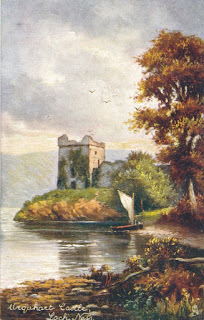 Urquhart Castle and Loch Ness, depicted on a vintage pre-1914 picture postcard (public domain)
Urquhart Castle and Loch Ness, depicted on a vintage pre-1914 picture postcard (public domain) Boatyard workers who examined the cruiser had found:
flesh and black skin an inch thick along the propshaft. [However,] the workers chiseled the flesh away and threw it into the Caledonian Canal. I said you stupid b-----s. It would have proved that Nessie was here.
Indeed it might. Certainly, to quote Adrian Shine of the Loch Ness Project when told of this incident:
Very frustrating. With modern DNA techniques we could have learned a lot about exactly what had caused the damage.
In fact, this was quite possibly the single greatest lost opportunity in the entire LNM history to conduct a direct scientific examination of Nessie, because there is no known animal species resident in the loch that is big enough to have caused such a collision.This ShukerNature blog article is excerpted from my book Still In Search Of Prehistoric Survivors.
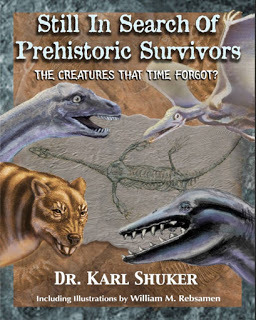 Still In Search Of Prehistoric Survivors
(© Dr Karl Shuker/Coachwhip Publications)
Still In Search Of Prehistoric Survivors
(© Dr Karl Shuker/Coachwhip Publications)
May 30, 2021
UNFURLING CHINA'S FENG-HUANG – THE 'OTHER' PHOENIX
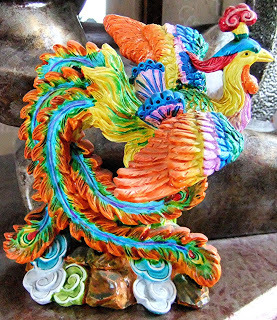 A multicoloured feng-huang figurine that I brought back home from Hong Kong in 2005 (© Dr Karl Shuker)
A multicoloured feng-huang figurine that I brought back home from Hong Kong in 2005 (© Dr Karl Shuker) One of the most famous legendary birds is the Egyptian phoenix, but traditional Chinese mythology has its very own equivalent of sorts – the 'other' phoenix, or, as it is commonly referred to in China, the feng-huang.
Just like the Egyptian phoenix, the feng-huang has been identified with a range of real birds. A very popular candidate is the familiar blue peacock Pavo cristatus (in depictions, the feng-huang's splendorous tail is frequently decorated with numerous ocelli or eyespots, thereby closely resembling the famously ornate train of this species).
 A male blue peacock displaying its spectacular ocellated train, consisting of tail covert feathers (public domain)
A male blue peacock displaying its spectacular ocellated train, consisting of tail covert feathers (public domain)
A second candidate is Asia's crested argus pheasant Rheinardia ocellata, which is another large, exotic galliform species sporting eyespot-enhanced plumage.
In an earlier ShukerNature article (click here to read it), I revealed that there have been suggestions that Egypt's phoenix may have been based upon preserved skins of certain bird of paradise species brought back to Phoenicia from their far-off New Guinea homelands by early seagoing traders. Moreover, in 1967 a Chinese researcher postulated that one or more birds of paradise native to New Guinea may have been the basis for the feng-huang too.
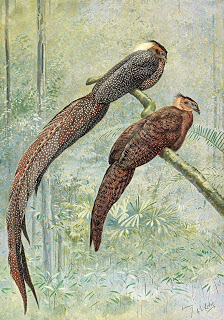 A pair of crested argus pheasants painted by George Edward Lodge, the larger specimen being the male (public domain)
A pair of crested argus pheasants painted by George Edward Lodge, the larger specimen being the male (public domain)
In a lengthy paper written principally in Chinese (and published by the Bulletin of the Institute of Ethnology of Taipeh, Academia Sinica, during autumn 1967), Tzu-Chiang Chou based his assertion upon four primary points, summarized as follows:
1. According to Tzu-Chiang Chou, in the Chinese hieroglyphics of the Shang Dynasty (1384—1111 BC), the shape of the Chinese character termed ‘Feng’, denoting the phoenix, resembled the typical, effusively-plumed Paradisaea birds of paradise more closely than any other proposed contender for this fabulous bird’s identity.
2. The shape used for the character denoting the wind within this system of hieroglyphics was comparable to the Feng character, implying that the phoenix was in some way associated with the wind.
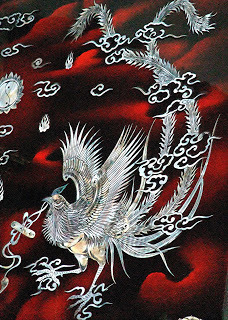 A sumptuous Chinese wall plaque in which a Chinese phoenix is portrayed in shimmering nacre or mother-of-pearl (© Dr Karl Shuker)
A sumptuous Chinese wall plaque in which a Chinese phoenix is portrayed in shimmering nacre or mother-of-pearl (© Dr Karl Shuker)
3. He offers many examples from ancient Chinese writings and from bird designs on the bronzewares of ancient China’s pre-Chin period (i.e. prior to 221 BC) that suggest a Paradisaea species as their model.
4. He presents material that he interprets as evidence for believing that as recently as 1100 AD (during the Sung Dynasty), southern China was home to two native species of bird of paradise, which have since become extinct.
From the examples of Shang Dynasty hieroglyphics depicting the ‘Feng’ and ‘Wind’ that Tzu-Chiang Chou provides, a certain, but by no means unequivocal, similarity to at least two different birds of paradise (greater, Paradisaea apoda, and king, Cicinnurus regius) is present, but his claim that a third example specifically comprises a depiction of a composite bird of paradise (created from the most striking characteristics of a wide range of different species) is less convincing. As for the wind connection, he points out that in Chinese the birds of paradise are referred to as ‘wind-birds’, because they fly against the wind.
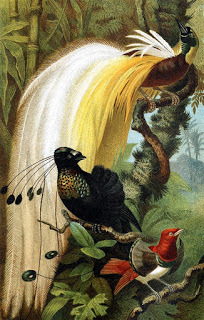 Chromolithograph from 1900 depicting a male greater bird of paradise (top) and a male king bird of paradise (bottom), plus a six-wired bird of paradise (centre) (public domain)
Chromolithograph from 1900 depicting a male greater bird of paradise (top) and a male king bird of paradise (bottom), plus a six-wired bird of paradise (centre) (public domain)
Within the ancient Chinese texts, the Chinese phoenix is described as having colourful plumage, long tufts of feathers sprouting from its flanks, a fondness for dancing, and communal behaviour – all features shared by the Paradisaea birds of paradise (whose males do display in groups rather than singly). Conversely, in more recent Chinese accounts a very different phoenix is described - a somewhat grotesque entity with a snake’s neck, a tortoise’s shell, and a fishtail – but Tzu-Chiang Chou believes that this image is wholly imaginary, not based upon observations of real forms.
So far, then, Tzu-Chiang Chou’s evidence for the identification of the Chinese phoenix as a Paradisaea bird of paradise is quite persuasive, but his fourth point is much more contentious. Quoting from various early Chinese encyclopedias, he provides descriptions of two exceptionally handsome birds supposedly native to China in those long-departed days, at least according to the authors of the descriptions.
 Male red bird of paradise, in Cassell's Book of Birds, 1870s (public domain)
Male red bird of paradise, in Cassell's Book of Birds, 1870s (public domain)
One bird, allegedly inhabiting Canton Province during the Sung Dynasty, referred to by the natives as the feng-huang, and said to have long sashes of red plumes on its flanks, beneath its wings, is identified by Tzu-Chiang Chou as the red bird of paradise Paradisaea rubra. This species is officially known only from the Western Papuan islands of Saonet, Waigeu, and Batanta (and perhaps Ghemien too).
The other mystery bird, reported from Kwangsi Province, again during the Sung Dynasty, and called the u-feng or black phoenix, was reputedly bluish-green and purple, with a head crest and an elongated tail with bunches of feathers at each end. Tzu-Chiang Chou considers this to be the long-tailed (=black) sicklebill bird of paradise Epimachus fastosus (formerly magnus).
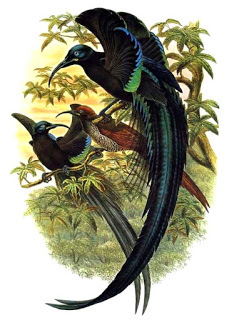 Two males and one female of the long-tailed sicklebill bird of paradise, painted by Richard Bowdler Sharpe (public domain)
Two males and one female of the long-tailed sicklebill bird of paradise, painted by Richard Bowdler Sharpe (public domain)
These identifications, however, are far from precise. Goldie’s bird of paradise Paradisaea decora and Count Raggi’s P. raggiana also have sprays of long red plumes emerging from their flanks beneath their wings; and the sicklebills do not have crests – the equally long-tailed species of astrapia do, but (in common with the sicklebills) they do not have bunches of feathers at each end of their tails. In any event, I consider it highly unlikely that any genuine birds of paradise have ever been native to China, even if we accept Tzu-Chiang Chou’s claim that in earlier days its climate was much warmer, and hence closer to the tropical temperatures of New Guinea.
Ornithological experts believe that the birds of paradise originated in the mid-mountain forests of New Guinea, and as the present diversity of species progressively evolved, the family’s range gradually expanded, infiltrating north-eastern Australia as its distribution’s southernmost limit and extending as far to the west as the Moluccas (home to Wallace’s standardwing Semioptera wallacei and the paradise crow Lycocorax pyrrhopterus).
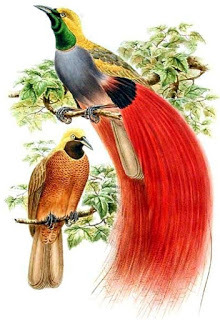 Richard Bowdler Sharpe's 1890s painting of a pair of Goldie's bird of paradise (public domain)
Richard Bowdler Sharpe's 1890s painting of a pair of Goldie's bird of paradise (public domain)
It is reasonable to suppose, therefore, that if the family were to send representatives beyond the Moluccas, ultimately reaching southern China, it would do so either via the Philippines, a handy series of stepping stones to the Asian mainland and thence China, or via a longer Sulawesi-Borneo-Vietnam course. Yet there is no evidence for the former existence of birds of paradise in any of these countries, thereby undermining support for their onetime occurrence further north-west, in China itself.
A far more likely option is that early travellers visiting New Guinea arrived at China with preserved bird of paradise skins, and perhaps even some live specimens, whose outstanding appearance would guarantee their documentation in major Chinese texts of the day – their authors probably being unaware that these birds had originated from beyond China.
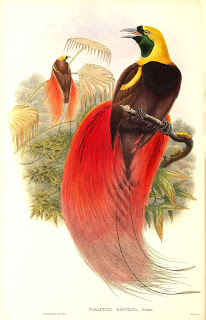 John Gould's painting of two adult male specimens of Count Raggi's bird of paradise (public domain)
John Gould's painting of two adult male specimens of Count Raggi's bird of paradise (public domain)
Another legendary Chinese bird that may conceivably have been inspired at least in part by bird of paradise skins or specimens is the vermilion bird. Totally distinct from the feng-huang, this noble and elegant bird is a mythological spirit creature, one of the four symbols of the Chinese constellations. Representing the south of China and the summer season, it is very selective where it perches and what it eats, and its gorgeous plumage incorporates many different hues of reddish orange.
Sadly, however, like so much in cryptozoology, all of this is mere speculation, nothing but unconfirmed conjecture at present, especially as illustrations can be notoriously inaccurate or so stylized that the true morphological appearance of their original subjects remains obscure.
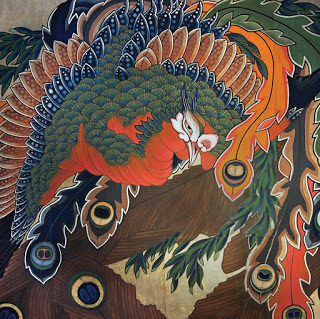 A Chinese phoenix exquisitely depicted by Katsushika Hokusai in c.1835 (public domain)
A Chinese phoenix exquisitely depicted by Katsushika Hokusai in c.1835 (public domain)
This ShukerNature blog article was adapted from a section in my book Extraordinary Animals Revisited.
 A large, modern-day, Chinese-style vase very handsomely decorated with a pair of traditionally-depicted feng-huang birds, photographed in daylight (on left) and at night (on right) (© Dr Karl Shuker)
A large, modern-day, Chinese-style vase very handsomely decorated with a pair of traditionally-depicted feng-huang birds, photographed in daylight (on left) and at night (on right) (© Dr Karl Shuker)
May 8, 2021
LEAST WEASELS, CANE WEASELS, WHITNICKS, AND DANDY DOGS - DEMYSTIFYING MUSTELIDS IS THE NAME OF THE GAME!
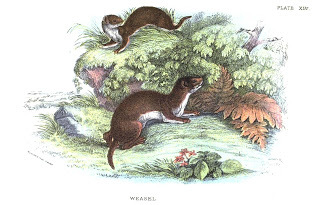 Exquisite 19th-Century colour-tinted engraving depicting a pair of Mustela nivalis, the common weasel, or – to avoid being labelled by pedants as nomenclaturally negligent – the least weasel (public domain)
Exquisite 19th-Century colour-tinted engraving depicting a pair of Mustela nivalis, the common weasel, or – to avoid being labelled by pedants as nomenclaturally negligent – the least weasel (public domain) Back in the mid-1960s, when I was just a small child, I was bought an alphabetically-arranged weekly partwork entitled Purnell's Encyclopaedia of Animal Lifethat ran for 96 weeks and which when complete yielded six hefty and exceedingly comprehensive full-colour volumes. Edited by famous British zoologists Drs Maurice and Robert Burton, these red-bound fact-filled, photo-brimming tomes totally enthralled me, and I read them over and over again. Moreover, I still own them today and they remain an extremely useful, informative source of reference. Indeed, it is perfectly true to say that this wonderful publication quite simply transformed my life as a budding zoologist, unveiling a vast array of extraordinary animals that were totally new to me. Crucially, it was also the very first zoological publication owned by me that included the taxonomic binomial names of the animals documented in its countless pages. (These binomial names, which trace their origin back to Linnaeus's revolutionary system of wildlife classification back in the 1700s, are commonly referred to colloquially as 'Latin names', even though many are derived from Greek rather than Latin.) As a result, I have been fascinated with zoological nomenclature and taxonomy ever since.
And so it was that while others of my age were memorizing football teams and car makes/models, I was enthusiastically learning the binomial names of as many animals as my besieged brain cells could accommodate, and then some, and I have continued to do so ever since. However, just like every other aspect of science, zoological nomenclature and taxonomy are ever changing, ever expanding, ever modifying as new information concerning the evolutionary origins and relationships of species and other taxa continues to emerge. Consequently, it should come as no surprise that many of the binomials and classifications of animals that I diligently learned six decades ago have since changed or transformed dramatically – but also sometimes confusingly – meaning that I am perpetually engaged in taxonomic catch-up, often having to abandon binomials that I've fondly recollected for countless years in favour of new, unfamiliar ones.
Sadly, these include the very first binomial that I ever learned, from my trusty Purnell's Encyclopaedia. It was Alopex lagopus, the Arctic fox, which has stayed with me ever since, never forgotten, a faithful reminder of where my enduring passion for such nomenclature began. And then, to my horror, some wretched wrecker of childhood memories in taxonomist form came along (albeit a fair few years ago now), and decided that the Arctic fox did not warrant its own genus, Alopex, distinct from Vulpes, which houses the true foxes, and should therefore be subsumed into their genus. Consequently, to my horror, the first binomial that I had ever leant was no more! Suddenly, "Alopex lagopus the Arctic fox" – the much-loved taxonomic mantra that had chanted happily away to itself in the backrooms of my memory for decades – had been rendered obsolete, jettisoned to nomenclatural obscurity as nothing more from now on than a synonym of Vulpes lagopus. The dread deed was done, and it is now this latter binomial that is recognized as the Arctic fox's official one – but although I outwardly accept it and grudgingly use it when writing about this species, inside my mind the Arctic fox is and always will be Alopex lagopus. So be it, forever and ever, amen.
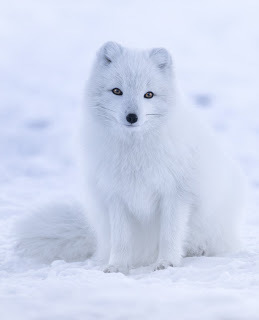 Resplendent in its all-white winter coat, the Arctic fox – forever Alopex lagopus to me! (public domain)
Resplendent in its all-white winter coat, the Arctic fox – forever Alopex lagopus to me! (public domain)
I mentioned earlier here that sometimes the changing of taxonomic names and classifications can be a source of confusion, which is where this ShukerNature blog article's mustelid theme now kicks in and is the reason for my prefacing it with an explanation of how and why binomials have always interested me.
Back when I was a child, most of the wildlife books that I owned readily differentiated three very small species within the genus Mustela. These were referred to as the common weasel (or simply as the weasel) M. nivalis (with a head-and-body length of 5-10 in and a tail length of 0.5-3.5 in, native to much of continental Europe as well as Great Britain but not Ireland), the pygmy weasel M. pygmaea (given as being smaller than M. nivalis, and native to Fareastern Russia, Siberia, and Mongolia), and the least weasel M. rixosa (given as being even smaller than M. pygmaea, native to Canada and parts of the northern USA, and listed back then in the Guinness Book of Records as not only the world's smallest species of mustelid but also its smallest species of any type of carnivoran, i.e. belonging to the taxonomic order Carnivora). So far, so simple – but then it all changed…
 Size comparison of Mustela nivalis with the European hare Lepus europaeus and a human hand (public domain)
Size comparison of Mustela nivalis with the European hare Lepus europaeus and a human hand (public domain)
Many years later, I started noticing in books and articles that M. nivaliswas now being referred to as the least weasel and being claimed to be the world's smallest mustelid and carnivoran. So what had happened to M. rixosa (and also M. pygmaea, for that matter)? This name-change was especially curious, given that the least weasel M. rixosa that I had grown up reading about was a wholly New World species whereas M. nivalis was a wholly Old World one. To quote the website NatureServe Explorer's 'Mustela nivalis Least Weasel' page as of today, 8 May 2021 (click hereto access the full page):
The North American population sometimes is treated as a separate species, Mustela rixosa. Confusion has existed for a long time regarding the taxonomic status of this species [M. nivalis] and its subspecies, particularly in Europe (see Sheffield and King 1994; Wozencraft, in Wilson and Reeder 2005).
How very true! Further research has revealed to me that generally, but by no means universally, taxonomists nowadays deem what used to be called the least weasel (i.e. the New World species M. rixosa) to be merely a subspecies of what used to be called the common weasel (or weasel) M. nivalis, thus renaming it M. n. rixosa, which is fair enough. However, they have also elected (for reasons that entirely escape me) to utilise the latter subspecies' original common name as the name for the entire species.
In other words, no longer is M. nivalis called the common weasel or weasel. Instead, it is now called the least weasel – which to my mind is a totally unnecessary and highly confusing name-change, especially for those like myself who have long known the least weasel to be the name of the New World's tiniest of tiny mustelids, but which is nowadays called Bangs' least weasel instead.
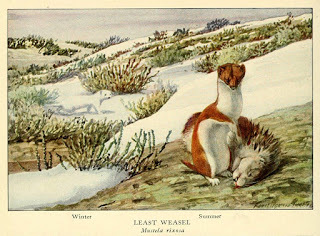 In summer and (white) winter coat, North America's least weasel M. (n.) rixosa (public domain)
In summer and (white) winter coat, North America's least weasel M. (n.) rixosa (public domain)
Moreover, the pygmy weasel M. pygmaea has been demoted to a subspecies of M. nivalis too. As a result, it has been renamed M. n. pygmaea, and is now called the Siberian least weasel instead of the pygmy weasel.
So instead of having a naming system for this trio of mustelids that was not only readily memorable by being succinct but also instantly conveyed useful information concerning them – 'common weasel', 'pygmy weasel', and 'least weasel' clearly revealing the sizes of these three forms relative to each other, self-evidently reducing in size from 'common' through 'pygmy' to 'least' – we now have one that is harder to remember and conveys no information whatsoever concerning their relative sizes. After all, how can we tell which is the biggest, the medium-sized, and the smallest from the names 'least weasel', 'Siberian least weasel', and 'Bangs' least weasel'? And there was I, thinking that the purpose of zoological nomenclature and taxonomy is to simplify animal classification and recognition!
[To make matters even more bewildering: by the 1970s, some authors had begun lumping together what until then had still been M. pygmaea from the Old World and M. rixosa from the New World, thereby creating what was now a circumpolar species. Very confusingly, however, instead of being given a new common name and a new taxonomic name (which would have made much more sense), this composite circumpolar species became referred by its New World component's names, i.e. as the least weasel M. rixosa. Also claimed as a separate species back then was the dwarf weasel M. minuta, smaller than the common weasel and native to parts of continental Europe but not the British Isles… but enough of taxonomic turmoil, time to move on, I think!]
Anyway, if even the scientific naming of creatures is far from immune to introducing confusion where only clarity should reign, how much more so when we turn our attention to local, non-scientific names, as exemplified once again by some ostensibly mystifying monikers of the mustelid variety.
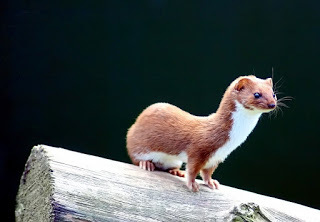 Mustela nivalis
at the British Wildlife Centre, Surrey, England (© Kevin Law/Wikipedia –
CC BY-SA 2.0 licence
)
Mustela nivalis
at the British Wildlife Centre, Surrey, England (© Kevin Law/Wikipedia –
CC BY-SA 2.0 licence
) Take, for instance, the so-called cane weasel. Also known variously as the miniver, mouse hound, or mousehunt, this cryptic carnivoran was once firmly believed in by many rural folk from southern England, who claimed that it was a discrete, second species of native weasel, one that was even smaller than M. nivalis. Gamekeepers vehemently attested to the reality of this minuscule mustelid, yet no specimens were ever submitted to museums or other scientific establishments for formal examination, and eventually this curious notion of a second British weasel species simply faded away. In a short but succinct 'Nature Note' article in London's Daily Telegraph newspaper for 6 January 1996, previously-mentioned British zoologist Dr Robert Burton offered three suggestions for the erstwhile belief in the cane weasel.
Firstly: M. nivalis is a noticeably variable species in terms of size, which is what had influenced the former taxonomic delineation of M. pygmaea and M. rixosaas separate species in the first place. Moreover, adult female specimens of M. nivalis can often be considerably smaller than adult males. Consequently, it would be easy for zoologically-untrained observers to spy smaller than average female specimens and wrongly assume that they must constitute a very diminutive separate species in their own right.
Secondly: M. nivalis produces two litters in a year. Consequently, it is possible that the so-called cane weasels are actually the tiny offspring of the first litter, which breed before they are full grown in size.
Thirdly: alternatively, it may be that the offspring of late-produced second litters of M. nivalis pass the winter at less than adult size and it is these overwintering under-sized specimens that have given rise to the cane weasel notion among rural observers.
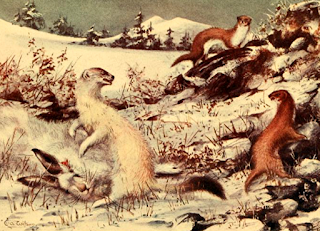 Painting of a stoat Mustela erminea in its white ermine winter coat with two least weasels close by, readily revealing how much larger is the stoat – in Gerald Edwin Hamilton Barrett-Hamilton's book A History of British Mammals, Vol 5, 1910 (public domain)
Painting of a stoat Mustela erminea in its white ermine winter coat with two least weasels close by, readily revealing how much larger is the stoat – in Gerald Edwin Hamilton Barrett-Hamilton's book A History of British Mammals, Vol 5, 1910 (public domain)
Another English belief in a distinct, smaller than normal weasel species originates in the southwestern county of Cornwall, and concerns the so-called whitnick. According to Cornish language and dialect sources that I have consulted, generally speaking 'whitnick' is simply a local name for M. nivalis. However, on 31 March 1964, a short letter written by Cornish reader S.M. Lanyon that was published in the then-weekly, now long-defunct British magazine Animals enquired whether the whitnick may be something much more interesting and special.
In his letter, Lanyon, based in St Ives, Cornwall, stated that the whitnick is claimed locally to be a cross between a weasel and a stoat, to be plentiful around there, and to have always been so. But was such a creature real, or just a Cornish story, Lanyon wondered. Back then, the editor of Animals was none other than the highly-acclaimed naturalist and pioneering wildlife film maker Armand Denis, who responded personally to Lanyon's letter, Denis's reply being published directly underneath it.
Like Burton would mention many years later in his own above-noted Daily Telegraph article, Denis referred first of all to the noticeable size disparity between the two sexes in M. nivalis (i.e. females being smaller than males). He then speculated that whereas 'cane weasel' appeared to be a special name given to the smaller, female sex of M. nivalis in Kent and Sussex, in Cornwall it was the larger, male sex of this same species that had been given a special name – whitnick – because the possibility that this cryptic creature was genuinely a hybrid of M. nivalis and the much bigger M. erminea seemed highly unlikely. And indeed, I have never uncovered any information concerning verified crossbreeds of these two species, despite having searched diligently during the many years that have passed since I first read Lanyon's letter and Denis's reply to it.
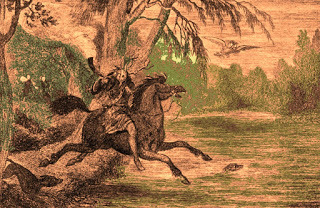 Atmospheric colour-tinted 19th-Century engraving of Herne the Hunter with two of his hounds (public domain)
Atmospheric colour-tinted 19th-Century engraving of Herne the Hunter with two of his hounds (public domain)
Finally: many years ago once again, I discovered this last snippet of unexpected information relating to weasels and weasel nomenclature in an equally unexpected source. Namely, Africa-based naturalist Peter Turnbull-Kemp's book The Leopard(1967), which I consulted when researching my own, very first book, Mystery Cats of the World (1989) – now republished in expanded, updated form as Mystery Cats of the World Revisited (2020). Here is the snippet in question, in which Turnbull-Kemp recalled an interesting memory from his childhood spent in England:
I myself can remember being warned as a boy against the risks in meeting supposed troops or packs of "bloodthirsty" weasels – known in my part of England by the rather attractive name of Dandy-hounds. Such "dangerous packs were only in evidence in times of extremely hard weather, and rare parties of weasels did in fact appear on rare occasions under such conditions. Needless to say, they were sometimes bold from hunger and possibly with curiosity, but utterly harmless.
I had previously been familiar with the longer term 'devil's dandy hounds', which is one of several referring to the supernatural, spectral hell hounds that according to various stories of British folklore accompany either the devil or the horned hunter Herne during the Wild Hunt. However, I had not previously encountered it in relation to weasels – nor indeed for that matter had I hitherto known about the notion of weasels forming hunting packs during harsh conditions.
Despite Turnbull-Kemp's reassurance that these musteline dandy hounds were totally harmless to humans, however, I subsequently read elsewhere a lurid account of a farm labourer that had allegedly been set upon one snowy, winter's evening by a savage swarm of these mini-mustelids, which he frantically warded off using his cart whip. Also of note is a supposed true-life story graphically entitled 'Weasels Ripped My Flesh!', published in the September 1956 issue of Man's Life(a long-since-defunct American men's action/adventure magazine), and the subject of that issue's eye-popping full-colour front cover painting by Wil Hulsey. However, although presented as the first-hand account of a man who had been attacked by a ferocious weasel pack after lying in wait to discover what had killed 90 ducks in just two nights at his Connecticut farm, and credited to a Mike Kamens, this was actually pulp fiction written under a pseudonym.
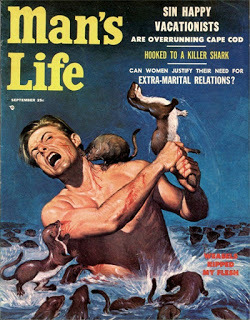 The fantastic front cover illustration by Wil Hulsey of the story 'Weasels Ripped My Flesh!' by Mike Kamens, from Man's Life, September 1956 (© Wil Hulsey/Mike Kamens/Man's Life/Crestwood Publishing Co – reproduced on a strictly non-commercial Fair Use basis for educational/review purposes only)
The fantastic front cover illustration by Wil Hulsey of the story 'Weasels Ripped My Flesh!' by Mike Kamens, from Man's Life, September 1956 (© Wil Hulsey/Mike Kamens/Man's Life/Crestwood Publishing Co – reproduced on a strictly non-commercial Fair Use basis for educational/review purposes only)
Happily, investigations of mine into the reality or otherwise of dandy hound packs duly revealed that such claims are baseless, nothing more than yet another example of weasel-inspired whimsy. In fact, M. nivalis is a very active but solitary hunter, although sometimes an adult female will be encountered chaperoning her offspring on training forays (the adult male playing no part in their rearing or training). Sadly, Turnbull-Kemp offered no sources or additional information to substantiate his claim that rare parties of weasels do occur occasionally during times of extremely hard weather.
Incidentally, the fact that weasels apparently do not hunt in packs at any time has not stopped the creation of several totally superfluous – and very silly-sounding – collective terms for this species (what is it with the bizarre compulsion to create inane collective terms for animals, even ones that by nature are solitary – other than to bamboozle ardent quizzers??). These include not only a pack but also a gang, a boogie, and even a confusion of weasels, the last-mentioned example being particularly apt, or ironic, given the circumstances!
In summary: intriguing and memorable though they may be, the multi-named Kentish cane weasel (aka miniver aka mouse hound aka mousehunt), the crossbred Cornish whitnick, and the dread droves of dandy hounds must all be relegated to the intangible realms of England's fascinating but entirely folkloric fauna.
 Weasels Ripped My Flesh!
– edited by Robert Deis with Josh Alan Friedman and Wyatt Doyle (© Robert Deis, Josh Alan Friedman & Wyatt Doyle/New Texture – reproduced here on a strictly non-commercial Fair Use basis for educational/review purposes only)
Weasels Ripped My Flesh!
– edited by Robert Deis with Josh Alan Friedman and Wyatt Doyle (© Robert Deis, Josh Alan Friedman & Wyatt Doyle/New Texture – reproduced here on a strictly non-commercial Fair Use basis for educational/review purposes only)
If you would like to learn more about the legendary 'Weasels Ripped My Flesh!' story and its fascinating link to equally celebrated music megastar Frank Zappa, please click hereto read an article by my longstanding Facebook friend Bob Deis, present on his Menspulpmags website. Bob has also included a reproduction of the original published version of it in his wonderful compilation of 22 classic stories from American men's pulp magazines, entitled – what else? – Weasels Ripped My Flesh!
Also, make sure that you check out Bob's fascinating compilation of cryptozoology-themed stories and reports from American men's pulp magazines – Cryptozoology Anthology: Strange and Mysterious Creatures in Men's Adventure Magazines.
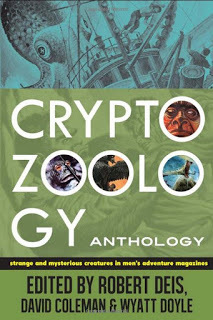 Cryptozoology Anthology
– edited by Robert Deis, David Coleman, and Wyatt Doyle (© Robert Deis, David Coleman & Wyatt Doyle/New Texture – reproduced here on a strictly non-commercial Fair Use basis for educational/review purposes only)
Cryptozoology Anthology
– edited by Robert Deis, David Coleman, and Wyatt Doyle (© Robert Deis, David Coleman & Wyatt Doyle/New Texture – reproduced here on a strictly non-commercial Fair Use basis for educational/review purposes only)
May 3, 2021
THE MONSTER OF DREAD END - REDISCOVERING A CHILLING CHILDHOOD PRECURSOR TO MY CAREER IN CRYPTOZOOLOGY
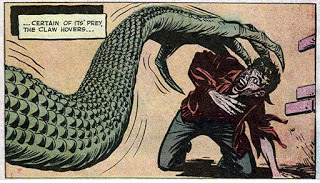 The dramatic, climactic panel from the legendary comic-strip horror story 'The Monster of Dread End' written by John Stanley and illustrated by Ed Robbins that first appeared in Ghost Stories, #1, September/October 1962, published by Dell Comics (© John Stanley/Ed Robbins/Ghost Stories/Dell Comics – reproduced here on a strictly non-commercial Fair Use basis for educational/review purposes only)
The dramatic, climactic panel from the legendary comic-strip horror story 'The Monster of Dread End' written by John Stanley and illustrated by Ed Robbins that first appeared in Ghost Stories, #1, September/October 1962, published by Dell Comics (© John Stanley/Ed Robbins/Ghost Stories/Dell Comics – reproduced here on a strictly non-commercial Fair Use basis for educational/review purposes only) As today has been yet another Bank Holiday Monday of the traditional wet'n'windy, stay-at-home type here in the UK, by way of light(?) relief I'll share with you tonight on ShukerNature a notable cryptozoology-relevant rediscovery made by me during the early hours of this morning. True, its subject certainly may not be notable to everyone, nor may it be what everyone would instantly or at least initially deem to be of cryptozoological relevance. However, my finding of it today almost by chance after having purposefully and diligently searched so many times before yet always in vain swiftly reminded me of how, in spite of its overtly bizarre nature, this very specific, never-forgotten item may well have played a subtle role in cultivating my curiosity about monsters and mystery beasts as a child, inputting only too memorably into the formative mind of a fledgling cryptozoologist the excitement as well as even sometimes the terror associated with such creatures. And the name of this unconventional yet indelibly imprinted source of proto-cryptozoological intrigue? The Monster of Dread End. But to begin at the beginning…
Sometime during the late 1960s or early 1970s, I was bought a very unusual hardback comic book. In outward appearance, it greatly resembled the familiar comic annuals that used to be produced for sale just before Christmas each year by all of the major British children's comics, a fair selection of which I would buy or have bought for me at one time or another down through my younger years. These included such fondly-remembered but long-since vanished titles as The Beezer, The Dandy, The Topper, The Beano (sole survivor today), Sparky, Buster, Cor!, Whizzer & Chips, The Eagle, Valiant, Lion, Tiger, and Jag. However, the contents of the annual-type comic book under consideration here were very different from the innocuous cartoon humour and 'boys-own' adventure serials present in those above-named titles. Indeed, to the impressionable, highly imaginative youngster that I was back then, they were for the most part quite nightmarish, even horrific, and I freely confess that unbidden thoughts about them gave me a fair few sleepless nights as time went on. This no doubt explains why I eventually discarded the book, about 2-3 years after having received it, but even today I can still vividly recall a fair amount of its contents, although I can neither remember its title nor its front-cover illustration (though it may have featured an evil spectral black horse – see later).
About 64 pages long and A4-sized, this annual-lookalike comic book contained a series of self-contained stories (somewhere around 10-12, if I remember correctly), each one presented in the traditional panel-type illustration format of comic strips. Some were in full colour, others in monochrome, although red/white was favoured over b/w, as far as I can recall. However, their one common attribute was that the theme of their stories was the supernatural and the unknown, presenting a diversity of fictitious but terrifying tales featuring the likes of malevolent phantoms and other malign presences, fatal premonitions, and monsters – including the afore-mentioned denizen of Dread End, which irresistibly captured in its hideous clawed grasp the near-mesmerized attention and tenacious, abiding remembrance of this youngster just as surely and unrelentingly as it did physically to the numerous children who were its doomed victims in the story.
(Incidentally, I should note here that until this morning's rediscovery I'd completely forgotten that this story's title was 'The Monster of Dread End', having readily remembered its plot and pictures down through the decades but not what it was actually called, which is why I'd experienced such problems in the past when seeking it out. Consequently, I'd concentrated my efforts instead upon trying to recall the title of the book containing it, entering all manner of word combinations into Google's search engine and image search in the hope of assembling a phrase close enough to the book's title for details to appear concerning it and/or a picture of its cover that might elicit some recollections, but nothing ever did. This morning, however, I tried a different tactic, but one that worked immediately. I simply entered 'giant hand sewers comic book' into Google Image's search engine, and up popped several panels from that still very familiar story, together with its hitherto-forgotten title and plenty of other details too, which will be revealed later.) Anyway, back to the story.
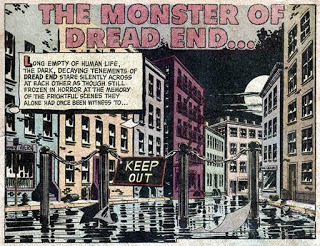 The very atmospheric opening panel from the legendary comic-strip horror story 'The Monster of Dread End' written by John Stanley and illustrated by Ed Robbins that first appeared in Ghost Stories, #1, September/October 1962, published by Dell Comics (© John Stanley/Ed Robbins/Ghost Stories/Dell Comics – reproduced here on a strictly non-commercial Fair Use basis for educational/review purposes only)
The very atmospheric opening panel from the legendary comic-strip horror story 'The Monster of Dread End' written by John Stanley and illustrated by Ed Robbins that first appeared in Ghost Stories, #1, September/October 1962, published by Dell Comics (© John Stanley/Ed Robbins/Ghost Stories/Dell Comics – reproduced here on a strictly non-commercial Fair Use basis for educational/review purposes only)
Set in an unnamed American town or city suburb, 'The Monster of Dread End' begins with the above-reproduced panel depicting and describing the dismal, derelict tenement blocks of Dread End, long since deserted and cordoned off with an official Keep Out sign attached to the chains encircling this accursed street and its immediate environs. The next few panels provide harrowing flashbacks that reveal how the horrors now inextricably associated with it began. Back then, Dread End was a bustling, happy street called Hawthorn Place – until that fateful early morning when a dead "balled-up thing" was found there, lying on the pavement "like an empty wrapper thrown carelessly aside but somehow still recognizable as having once been human". (Mercifully, no actual image of this object was presented, only the above-quoted description of it, so exactly what it looked like was left to the reader's imagination.) At the same time that horrified observers were gathering around it to stare in shock and revulsion, a panic-stricken young boy came running out of his family's apartment, yelling to everyone that his kid sister had gone missing, her bed empty…
Within a relatively short space of time, several other children from families living in Hawthorn Place also went missing from their beds. On each occasion, their absence was soon followed that same morning by the discovery close by of another of those horrific dead objects, lying on the street in silent, abject testimony to the fully-formed, living, loving child that had formerly existed in its stead. Even when frightened parents boarded up the windows in their children's bedrooms, the anomalous abductions continued, the boards being discovered broken and torn aside, the children gone, and the "balled-up things" found on the pavement nearby. Consequently, it was not long before the street's residents had all moved out, even those with nowhere else to go, content to live on the streets elsewhere if need be rather than remain in their homes and face the unexplained horror of Hawthorn Place. For despite all of their efforts, not only the local police but also the best criminological brains in the business called in from elsewhere were completely unable to discover who – or what – was responsible for this trail of terror and death.
Years went by, and Hawthorn Place, now redubbed Dread End due to its infamy, became encircled by other empty streets, yielding a veritable domain of the damned, a no-man's land of the lost, because no-one wanted to live even close to, let alone within, this sinister street. Nor did anyone ever set foot near it – until one particular night. That was when teenager Jimmy White ventured alone into the grim, dark shadows of Dread End in search of an answer to its foul mystery, seeking the cryptic Monster of Dread End itself, whatever or whoever it may be – because seven years earlier, he had been that panic-stricken young boy who had run outside shouting that his kid sister was missing, her bed empty. She had been the Monster's first victim, her remains being the first of those horrific "balled-up things". Jimmy had vowed vengeance ever since, and now he was here to take that vengeance, although, armed with nothing more than a police whistle with which to alert the cops patrolling other streets in the vicinity if should he encounter his quarry, he was by no means clear about how to do so. Nevertheless, he intended to try, somehow, for his sister.
Hours later, however, with nothing seen or heard, Jimmy conceded to himself that he was probably years too late, that the culprit had no doubt moved on long ago. Yawning and stretching in the first light of dawn, he was just about to do the same, when suddenly, causing him to freeze in mid-stretch, a nearby manhole cover began to rise, then slipped to one side – as a huge five-fingered long-clawed hand covered in livid-green reptilian skin slowly emerged, followed by an unimaginably lengthy, similarly-scaly arm. Were it not for it terminating in that grotesque taloned hand instead of a head, the arm would have resembled an anaconda-like snake, as more and more of its immensely flexible, serpentine form continued to emerge. While an unbelieving Jimmy watched in absolute horror, standing stock-still for fear of alerting this obscene, repellent entity to his presence, the hand and arm rose up against the wall of a building close by, stretching ever upwards, feeling, searching, blind but evidently sentient, and quite obviously seeking prey.
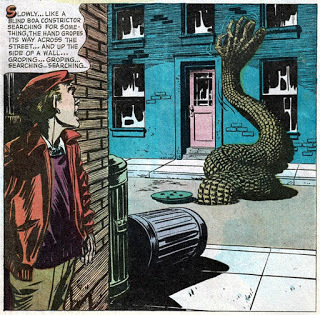 Seeking prey – a panel from the legendary comic-strip horror story 'The Monster of Dread End' written by John Stanley and illustrated by Ed Robbins that first appeared in Ghost Stories, #1, September/October 1962, published by Dell Comics (© John Stanley/Ed Robbins/Ghost Stories/Dell Comics – reproduced here on a strictly non-commercial Fair Use basis for educational/review purposes only)
Seeking prey – a panel from the legendary comic-strip horror story 'The Monster of Dread End' written by John Stanley and illustrated by Ed Robbins that first appeared in Ghost Stories, #1, September/October 1962, published by Dell Comics (© John Stanley/Ed Robbins/Ghost Stories/Dell Comics – reproduced here on a strictly non-commercial Fair Use basis for educational/review purposes only)
Jimmy had no idea what it was or where it had originated, but in that moment he knew with absolute certainty that he had solved the mystery of all of those missing children's gruesome fates, including that of his sister. They had been seized in their beds by this vile abomination, which had been lurking in the sewers of Dread End, and was still living there today, emerging at daybreak in the hope of abducting further victims to sustain its foul existence.
In his shock at what he had just seen, Jimmy lost his grip on his whistle, which fell to the ground, clattering on the pavement. Instantly, the hand and arm shot back down inside the manhole with lightning speed. So although it couldn’t see, this eerie entity could certainly sense the vibration of Jimmy's whistle hitting the floor. That must have been how it had traced its young victims, sensing the subtle vibrations that they had made while lying asleep in their beds all those years ago.
Alone once more amid the foreboding, unnatural silence of Dread End, Jimmy started debating with himself whether he'd be able to escape if he fled, or whether the monster would re-emerge and grab him straight away if it sensed his movements. Yet even before he had chance to come to a decision, that terrible clawed hand and snake-like arm did indeed emerge – and this time it was moving directly towards him! Again, Jimmy froze, not moving a muscle as the hand groped ever closer, ever nearer to his shadow-concealed form squatting in a dead-end alley. But then it paused, and moved instead towards an open, lidless dustbin (or garbage can to my US readers), lying on the ground right next to Jimmy. Its taloned fingers reached inside, but found nothing there, so as if in impotent rage the hand grasped the bin, and closed its fingers around it, crushing it as if it were made of tissue.
Nevertheless, the bin had apparently distracted the monster's attention from Jimmy, because instead of turning back towards him, the hand and arm, still emerging in seemingly limitless length from the manhole, moved off, groping blindly along a street leading away from the petrified teenager. What to do now? Jimmy stayed squatting in the dead-end alley, figuring that the more of this monster that emerged and moved on down the street, the further away from him its deadly hand would be – until a sixth-sense survival instinct suddenly kicked in. Jimmy looked behind him – and looming directly above him was the hand! Unbeknownst to Jimmy, it had entered a window in a tenement block further down the street, and by a series of sinuous, silent loops of its immensely lengthy, flexible arm in and out of other windows the hand had cunningly doubled back towards Jimmy and had finally emerged from a window overlooking the very alley in which he was crouching!
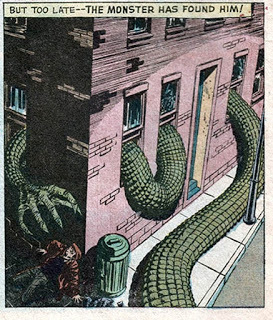 It's behind you! A panel from the legendary comic-strip horror story 'The Monster of Dread End' written by John Stanley and illustrated by Ed Robbins that first appeared in Ghost Stories, #1, September/October 1962, published by Dell Comics (© John Stanley/Ed Robbins/Ghost Stories/Dell Comics – reproduced here on a strictly non-commercial Fair Use basis for educational/review purposes only)
It's behind you! A panel from the legendary comic-strip horror story 'The Monster of Dread End' written by John Stanley and illustrated by Ed Robbins that first appeared in Ghost Stories, #1, September/October 1962, published by Dell Comics (© John Stanley/Ed Robbins/Ghost Stories/Dell Comics – reproduced here on a strictly non-commercial Fair Use basis for educational/review purposes only) The hand lunged down at Jimmy, but the youth was able to dodge its terrible clawed fingers, yet found himself trapped inside the alley, pressed against its dead-end wall. The hand lunged again, and again, Jimmy desperately striving to avoid its lethal grasp, but then, tiring and flustered, he stumbled, losing his balance. And as the terrified teenager crouched, knowing all too well that he could not escape, the hand triumphantly hovered over him, in an almost exultant stance, like a hooded venomous cobra of death about to wield its fatal strike at last (see the panel opening the present ShukerNature article that illustrates this dramatic, climactic scene).
Then, without warning, a deafening hail of bullets shattered the stillness of the street, round after round after round, from all manner of firearms, and all aimed directly at different portions of the monster's gigantic serpentine length. Its murderous fingers stiffened, and then its entire hand collapsed near to where Jimmy was slumped, prone with fear. Whatever it had been, the Monster of Dread End was no more. Its hand lay palm-upwards on the ground inside the alley, and crimson rivers of blood gushed forth from its arm, which had been blown apart, broken up into several discrete portions by the intensity of the barrage of artillery brought to bear against it.
A number of figures now stepped out of the shadows and deserted buildings where they had previously been in hiding, including uniformed policemen, bazooka-toting soldiers, and plainclothes officials. One went over to the hand and began examining its palm, noting that it contained pores through which the creature had evidently absorbed the blood and other body fluids obtained from its victims after its hand had crushed them.
The police apologized to Jimmy for not having appeared on the scene earlier, explaining that they had always been here and knew all about the monster, hoping that somehow, some day, they would destroy it, but needing to wait until enough of the arm had emerged to ensure their success in killing it when firing upon it, as opposed to merely wounding it. However, it had always retreated back inside the manhole cover at the slightest indication of danger. So when they spotted it pursuing Jimmy, they had poised themselves in readiness, and once a considerable length of its arm had emerged, they saw and took their best-ever chance of ending for all time the monster's reign of terror, and which now, at last, was indeed over.
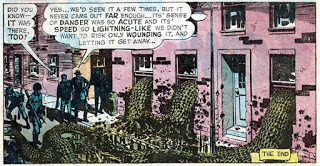 The victorious concluding panel from the legendary comic-strip horror story 'The Monster of Dread End' written by John Stanley and illustrated by Ed Robbins that first appeared in Ghost Stories, #1, September/October 1962, published by Dell Comics (© John Stanley/Ed Robbins/Ghost Stories/Dell Comics – reproduced here on a strictly non-commercial Fair Use basis for educational/review purposes only)
The victorious concluding panel from the legendary comic-strip horror story 'The Monster of Dread End' written by John Stanley and illustrated by Ed Robbins that first appeared in Ghost Stories, #1, September/October 1962, published by Dell Comics (© John Stanley/Ed Robbins/Ghost Stories/Dell Comics – reproduced here on a strictly non-commercial Fair Use basis for educational/review purposes only)
Although I hope that you've enjoyed my verbal retelling of 'The Monster of Dread End', nothing can compare to the original illustrated, scripted comic-strip version. So please click here to view (and also, if you so choose, download) this entire comic-strip story.
As I noted when introducing the present ShukerNature blog article, this comic-strip story may well have helped to incite my cryptozoological curiosity, because even though its own monster was so outrageously bizarre and grotesque, it probably played its part alongside a host of other influencing factors in encouraging my mind to consider whether remarkable creatures still unknown to science might actually exist. True, they were highly unlikely to be anything even remotely as incongruous as this macabre entity, but with Nessie frequently hitting the news headlines at that time, not to mention the Patterson-Gimlin bigfoot film and yeti reports, I was becoming increasingly aware that mystery animals may indeed exist. As a result, and despite knowing full well that it was entirely fictitious, even as a youngster I enjoyed hypothesizing how such a creature as the Monster of Dread End could arise.
Needless to say, I swiftly dismissed any conjecture that the hand and arm may constitute just one limb of a truly colossal sewer-dwelling mega-monster sporting other limbs as well as a head, neck, torso, and possibly even a tail too, because such a veritable mountain of living flesh existing inside the region's sewers would readily block them for miles around in every direction, rapidly causing floods, road upheavals, and all manner of other dramatic indications of its subterranean presence. In addition, unless it had countless arms with body fluid-absorbing hands emerging from manholes the length and breadth of the region concealing this underground horror (a phenomenon that in itself couldn’t help but be noticed pretty darn quickly, let alone the huge body count of victims soon arising from such widespread predation), it assuredly could not sustain such a vast bulk if it relied entirely upon just one single hand to obtain all of its necessary nutrients.
Therefore, I reasoned, the ultra-flexible arm must itself be the monster's body, an immensely long one, but a body nevertheless – not so much a sewer alligator, therefore, as a sewer super-snake or snake-like reptilian entity. But what about the hand? Either the creature kept its head hidden deep in the bowels of the sewers and hunted by means of a highly-modified tail whose terminal portion had evolved into a grasping, absorbing analogue of a pentadactyl hand, which seemed totally ludicrous; or, admittedly only slightly less so, the hand was actually the creature's highly-modified head instead, again having evolved into a grasping, absorbing analogue of a pentadactyl hand.
Speculative evolution is an engrossing subject in its own right. So even though it would struggle, I feel, to tender a plausible scenario for the morphological development of anything recalling Dread End's dreadful devourer, once again this latter comic-strip cereation assisted in directing my attention and cogitations towards that field of analysis too. In short, 'The Monster of Dread End' story was influential in nurturing my early interests in both cryptozoology and speculative evolution.
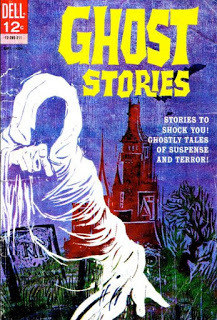 Front cover of Ghost Stories, #1, September/October 1962, published by Dell Comics (© Ghost Stories/Dell Comics – reproduced here on a strictly non-commercial Fair Use basis for educational/review purposes only)
Front cover of Ghost Stories, #1, September/October 1962, published by Dell Comics (© Ghost Stories/Dell Comics – reproduced here on a strictly non-commercial Fair Use basis for educational/review purposes only)
But what is the story of this story? That is to say, who created it, where did it originate, and what else, if anything, is known about it? This is what I was investigating early this morning, and I succeeded in uncovering some fascinating facts. It turns out that 'The Monster of Dread End' was the brainchild of a famous American comic book writer and cartoonist named John Stanley (1914-1993), whose foremost claim to fame was that he scripted (and also drew many of) the much-loved, exceedingly popular Little Lulu children's comic books from 1945 to 1959. However, in 1962 (not 1968, as sometimes incorrectly claimed), Stanley's creativity was channeled down a very different, much darker direction when he wrote all four comic-strip stories in the very first issue (September/October 1962) of a brand-new comic book published by Dell Comics and entitled Ghost Stories(which ran for 37 issues, folding in 1973). As this comic book's specific genre was horror/suspense, Stanley's quartet of stories were aimed at a much more mature readership than his previous work, their subjects all directly linked to the supernatural or unexplained mysteries, and one of these stories was none other than 'The Monster of Dread End', which was vibrantly illustrated by Ed Robbins. The other three were 'The Black Stallion' (no relation whatsoever to the same-named series of children's novels by Walter Farley; click hereto view it), 'The Werewolf Wasp' (click here to view it), and 'The Door' (click hereto view it).
I was startled to discover when researching this subject that even today, almost 60 years after its original publication, the Sept/Oct 1962 debut issue of Ghost Stories is popularly claimed among comic book devotees to be the scariest single comic book issue ever published, and 'The Monster of Dread End' the scariest single comic-strip story (little wonder why I found it so unnerving, albeit fascinating, as a child!).
Indeed, both this issue and this particular story within it have attained legendary status in such circles, to the extent that there is even a Spanish stop-motion mini-movie based upon the Dread End monster (which I'd love to see but haven't been able to locate anywhere online so far – suggestions?), as well as Horror Show Mickey's expanded, 15.5-minute retelling of its story currently on YouTube (click hereto view this, which features much of the original comic-strip visuals, although some of its panels have been re-ordered in order to fit the story's reworking by HSM). In 2017, a Kickstarter project was launched by Emmy-award-winning visual effects artist and publisher Ernest Farino whose aim was to fund the production of a professional trailer that could then be utilised in pitching for the production of a stop-motion feature-length movie based upon this iconic story, but sadly it did not reach its targeted goal (click here for further information). Given the sensational CGI capabilities now available to film producers, however, perhaps this latter technology may offer a more viable alternative way forward in creating what could be a truly spectacular full-length Monster of Dread End movie.
I have also ascertained that the still-unidentified annual-type comic book that I owned as a child in which 'The Monster of Dread End' appeared was evidently a compilation of comic-strip stories from a number of different issues of Ghost Stories, because when I checked down lists, titles, plot details, and images from those original issues I found other stories that I can remember from that annual. These latter include 'Blood, Sweat and Fear' and 'When Would Death Come For Daniel DuPrey?' (both of which originally appeared in Ghost Stories #3), written by Carl Memling and illustrated by Gerald McCann.
All that I need to do now, therefore, is discover the identity of this elusive volume. And so until/if ever I do, I shall continue to search for it online and anywhere else that I can, as and when the mood takes me. Call it a work in progress. Obviously, however, if anyone reading this article can offer me any suggestions, information, or assistance relating to my ongoing quest, I would be truly grateful. Who knows – if I do find out what it is, I might even then seek out a copy to purchase and reacquaint myself with its spine-chilling contents. Then again, in view of how they haunted my nights, albeit so very long ago now, might it be best to let sleeping dogs, and absent annuals, lie?
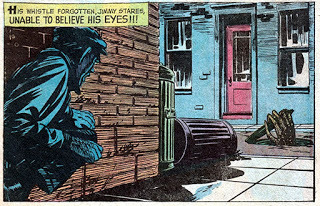 Revealed at last! A panel from the legendary comic-strip horror story 'The Monster of Dread End' written by John Stanley and illustrated by Ed Robbins that first appeared in Ghost Stories, #1, September/October 1962, published by Dell Comics (© John Stanley/Ed Robbins/Ghost Stories/Dell Comics – reproduced here on a strictly non-commercial Fair Use basis for educational/review purposes only)
Revealed at last! A panel from the legendary comic-strip horror story 'The Monster of Dread End' written by John Stanley and illustrated by Ed Robbins that first appeared in Ghost Stories, #1, September/October 1962, published by Dell Comics (© John Stanley/Ed Robbins/Ghost Stories/Dell Comics – reproduced here on a strictly non-commercial Fair Use basis for educational/review purposes only)
April 6, 2021
SOLVING THE RIDDLE OF THE SEA SCOPIUM - A FISHY TALE FROM EAST SUSSEX
 Life restoration model of a Eurypterussea scorpion, exhibited in the Smithsonian Institution's Hall of Fossils (© Ryan Somma/Wikipedia –
CC BY-SA 2.0 licence
)
Life restoration model of a Eurypterussea scorpion, exhibited in the Smithsonian Institution's Hall of Fossils (© Ryan Somma/Wikipedia –
CC BY-SA 2.0 licence
)
The eurypterids or sea scorpions of prehistory are unquestionably among the most extraordinary, physically spectacular creatures known exclusively from the fossil record. They consist of a long-extinct group of arthropods – that incomparably diverse assemblage of invertebrates united morphologically (but no longer taxonomically within a single phylum) by their jointed limbs. Including among their number the largest and most spectacular of all arthropods, attaining a total length of up to 8 ft in one species (Jaekelopterus rhenaniae), the sea scorpions were only distantly related to modern-day scorpions, as they were much more closely allied to the horseshoe crabs. They had reached their zenith of evolutionary of development by the late Silurian Period (approximately 420 million years ago) and had disappeared entirely from the fossil record by the close of the Permian (around 170 million years later), victims of the mass extinction that occurred at that time.
Most sea scorpions were generally elongate - commencing with a broad prosoma (the combined head and thorax) whose rounded head sported a distinctive pair of laterally-sited compound eyes and elongated mouth, and whose short thorax bore six pairs of limbs. One pair, the chelicerae, were jaw-parts (which attained an exceptional degree of development in Pterygotus species, resembling pincer-like grasping organs). The others were true legs (which in some species were so stout that they may have enabled these particular forms to walk on land).
Of those true legs, the most posterior pair was much larger and flatter than the rest, terminating in oval plates or paddles - undoubtedly constituting the principal swimming organs, but possibly serving as anchors too, or as scoops for digging up mud on the sea bottom where these creatures may have rested or hidden themselves. These wider legs earned the sea scorpions their scientific name - 'eurypterid' translates as 'broad wing', alluding to the wide paddles.
 Examples of pterygotid eurypterids, size not to scale (© Junnn11/Wikipedia –
CC BY-SA 4.0 licence
)
Examples of pterygotid eurypterids, size not to scale (© Junnn11/Wikipedia –
CC BY-SA 4.0 licence
)
The abdomen or opisthosoma was divided into two morphologically distinct sections. The forepart, known as the mesosoma, consisted of seven squat segments. The posterior part or metasoma consisted of five tapering cylindrical segments, the last of which bifurcated into two lobes - between which, concluding the sea scorpion's morphological roll-call, arose a long pointed spine (or, in some species, a short flat plate) called the telson or tail.
During their evolution, the sea scorpions adapted to living in brackish waters too, and even entered freshwater. Indeed, based upon some exceptional eurypterid fossils unearthed during the 1980s at East Kirkton in West Lothian, Scotland, palaeontologists believe that certain sea scorpions might even have been terrestrial. And if their lineage has persisted into the present day, 245 million years of intervening evolution could have engineered many other changes too, yielding creatures quite different in form and lifestyle from their Permian predecessors.
But what has all of the above information on sea scorpions to do with the mystery creature under consideration in this present ShukerNature article? In reality, nothing at all, were it not for a very confusing similarity of names, which, until I investigated it, had prevented the true nature of the creature in question from being recognised for what it truly is. Happily, all will now be revealed, in the curious case of the East Sussex sea scopium.
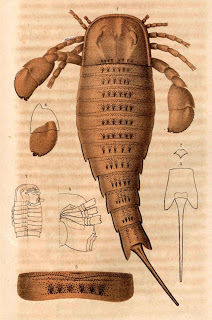 Exquisite vintage illustration of a Eurypterus remipes sea scorpion from 1858 (public domain)
Exquisite vintage illustration of a Eurypterus remipes sea scorpion from 1858 (public domain)
During early May 1986, Channel 4, a British television station, broadcast a little-known true-life film that had been made in 1972 and was entitled The Moon and the Sledgehammer. Its subject was the Pate family, whose home was situated deep in some woods near Newhaven in East Sussex, southern England, and whose patriarch was Old Man Pate – who recollected seeing a marine creature that he referred to as a 'sea scopium'. According to his description, it "looks like an old ship's sailing cloth in the water...They're black...It's got a head like a frog, but it's all goldy colour round, and its eyes stick out a bit, bulge fashion...It was about 7-8 ft under the water".
Pate had considered pulling it out of the sea to observe it more closely, but when he saw its large mouth, and realised that it was looking at him, he changed his mind. Afterwards, however, he regretted this, and in the film he announced plans to build a semi-submersible boat in which to look for the creature again. But what might it have been? Surely not a living sea scorpion??
Although the term 'sea scopium' naturally evokes images of eurypterids, there is a much simpler explanation available here. Pate's account recalls a fish called the sea scorpion – Myoxocephalus scorpius. Up to 2 ft long and black when fully mature, also referred to as the shorthorn sculpin, and a member of the taxonomic family of fishes known as cottid sculpins, this is a large-mouthed, frog-faced lurker among stones and seaweed on rocky seafloor with mud or sand. It is found in the English Channel, and the Atlantic north of Biscay, as well as the Arctic basin including the Siberian and Alaskan coasts. True, the head of this species is not golden, but in the film Pate stated that the sun was shining down through the water, so this no doubt gave the creature's head a golden sheen. Exit the 'sea scopium' from any further cryptozoological consideration.
Dorsal view of a sea scorpion of the shorthorn sculpin kind (© Genet/Wikipedia – CC-BY-SA 3.0 licence )
Many years ago, in a report describing a new 3-ft-long species of Mixopterus sea scorpion, Norwegian palaeontologist Prof. Johan Kiaer recalled the thrill of its discovery:
I shall never forget the moment when the first excellently preserved specimen of the new giant eurypterid was found. My workmen had lifted up a large slab, and when they turned it over, we suddenly saw the huge animal, with its marvelously shaped feet, stretched out in natural position. There was something so lifelike about it, gleaming darkly in the stone, that we almost expected to see it slowly rise from the bed where it had rested in peace for millions of years and crawl down to the lake that glittered close below us.
No doubt cryptozoologists share a similarly dramatic dream – to haul up a living sea scorpion from the depths of the oceans or even from the muddy bottom of a very large freshwater lake. Certainly, there have been some claims of this nature made down through the years in relation to various unidentified aquatic mystery beasts. And who knows – somewhere out there, perhaps there really are some post-Permian, present-day eurypterids, indolently lurking in scientific anonymity? Yet if the terminological tangle disentangled here that had hitherto hindered the delineation of these palaeontological sea scorpions from their modern-day piscean namesake is anything to go by, however, this prospect seems no more likely than the resurrection of Kiaer's fossilised specimen from its rocky bed of Silurian sandstone.
My sincere thanks to longstanding friend and crypto-colleague Sally Watts for kindly making available to me for personal viewing a copy of The Moon and the Sledgehammer after I'd mentioned reading a short, puzzling newspaper cutting referring to its sea scopium.
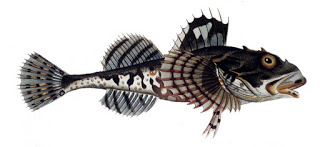 Lateral view of the shorthorn sculpin aka sea scorpion (public domain)
Lateral view of the shorthorn sculpin aka sea scorpion (public domain)
April 3, 2021
UPDATING THE LOUISIANA GIANT SPIDERS SAGA
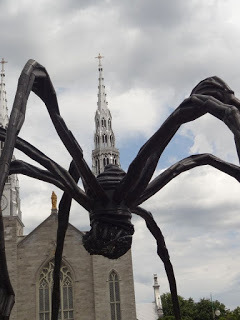 Giant spider sculpture in Ottawa, Canada (© Markus Bühler)
Giant spider sculpture in Ottawa, Canada (© Markus Bühler)
Last year, I posted a 2-part ShukerNature blog article of mine (click here and here to access it) concerning the alleged encounters during 2005 and 2007 by various Louisiana-based U.S. army personnel with some incredibly huge spiders. Unsurprisingly, it attracted a great deal of attention, especially as by all the fundamental laws of biophysics such creatures shouldn't – couldn't – exist. The information concerning these immense arachnids was provided to me by one of their reputed eyewitnesses, and he gave me full permission to publish all of it, on the sole condition that I did not make public his identity, which I have not done. Instead, I refer to him merely as Sgt S.
My 2-part article engendered a fair few comments from readers, some of which queried certain technical and military aspects of Sgt S's testimony. As a result, I have recently received some additional information from him, not only addressing those queries but also providing further insights into the creatures that he and others allegedly encountered. Moreover, he has provided me with a series of truly startling, thought-provoking scale drawings that readily reveal the supposed sizes of those spiders alongside an average human. As noted above, the zoologist in me cries out that such creatures simply cannot be. Equally, however, Sgt S's extensive, impassioned communications are ones that ostensibly originate from someone who was truly terrified and still patently haunted by what he claims to have seen.
As before, Sgt S has kindly granted me full permission to publish these updates under the same condition as before, that he remains anonymous, and to which I fully accede. Personally, however, I can see no feasible way via which the diametrically opposite, mutually exclusive disparity between the biological incongruity of the spiders and the apparent honesty of his belief in what he claims to have seen can be resolved. So I choose instead to present Sgt S's additional information and scale drawings herewith without comment from me, but in the form of a new article that will serve as a publicly-available record of the latter data's existence, which I feel needs to be done.
I received the first of Sgt S's new emails to me just over a fortnight ago, on 14 March 2021, in which he stated: "I finally saw your blog postings of my accounts with the giant spiders at Fort Polk. Thank you so much for bringing this story to light and keeping my name out of it. After reading it all over again I remembered a few more details from the 2005 sighting, regarding the animals' behavior that are significant enough to include".
On 18 March, Sgt S. added:
I was so traumatized by these events that I became disassociated, as if this were too unbearable to think about or as if it happened to someone else. To be clear on the retelling of these parts of the story, I did not fully recall the entire play-by-play of events, as it was so hard to deal with, that I blocked it out trying not to think about it. I have not talked about it at all with anyone until writing about it with you, 15 years later. Now it haunts me to even see a large dog lose in the park as that is the general size of the creature’s torso, without the 6-inch venomous fangs and long creepy legs. I was finally able to talk about it with a friend from work who is very open-minded to this sort of thing and that helped me to decide to write these additional details. You have my permission to publish as agreed upon before.
I must discourage anyone from trying to get near one of these things, or even walking in their area as they are extremely dangerous, venomous, man-eating, ambush predators that can move with tremendous force and speed.
He then presented an extensive account, which he revised slightly during some subsequent emails. This is his finalised version. Be sure to check back to my previous 2-part article in order to set the scene and read in context what is now presented below:
2005 Sightings
Animal Type 1A
On the night of the first encounter in 2005, when I first saw this thing that I will label Type 1A, I could not believe what I was seeing. In the heat of the moment, I charged forward and used my M4 carbine weapon’s buttstock to smash Type 1A in the head repeatedly, swinging wildly with my weapon at its legs while kicking and screaming at it at the top of my lungs. The flashlight shining directly in its eyes illuminated the eye tube itself making it appear light blue. I can compare it to being in a dark room and shining a light into to the bottom of a clear glass bottle filled with clear viscous fluid or clear jelly. The eyes of course were outwardly convex and had no eyelids. Before I charged, Type 1A tilted its head to the side and around so I could see the light all the way inside its head and there were increasingly smaller rings inside the eye tube. I think the adrenaline from my fight or flight instinct kicked in when I saw it moving. Type 1A backed up and sprayed a mist of foul-smelling liquid at us from about 5 or 6 feet away. The pheromone-laced liquid came out from the animal’s mouth, (or likely from glands near its mouth) and initially fanned out like water from an automotive windshield wiper nozzle, before dispersing into a mist. It happened very suddenly while I was firing blank 5.56mm rounds in its face, so it may have been a defensive response. The scent was a mix of ammonia and strong animal musk, like the scent of a cat marking its territory but much more pungent. The smell was not as bad as Skunk spray but more of a wet, swampy undercurrent of stench. With the sound and flash from 30 blank rounds, Type 1A turned its back and fled very clumsily, tumbling into its own legs, and smashing into the trees and sticks on the wooded area and was feeling its way around trying to find a path to escape before it scampered out of sight. I believe these things cannot see very well like most spiders and instead follow their noses (or whatever olfactory organs a spider has).
After I cut SGT Becky loose from the thick threaded silk, I became entangled and stuck to the ground. While SGT Becky was screaming and running back to our tent, I was nauseated from the pungent spray and basically frozen in fear, unable to move my legs. I then changed magazines in my weapon and made a Morse code S.O.S signal by firing a three-round burst, followed with three separate single-round shots, finishing with another three-round burst. I did this pattern three times. I could still hear movement in the trees from the direction where Type 1A fled, so I frantically cut away blindly at the dirt trying to free myself until I could get up and run like the devil back to our tent. I was very disoriented, dizzy, and itchy on my exposed skin as was SGT Becky. In retrospect, I believe this was due to a neurotoxic effect on the inch-long bristles or hairs we found all over our uniforms that I believe were ejected from Type A1 in a defensive reflex. Common tarantulas are known to shoot bristles or urticating hairs from their abdomens, to ward off predators. The bristles were black, white, and tan. Some of these were collected in a zip lock bag but the senior leadership took these away with any other evidence.
Later when they asked me to describe what I saw, I recalled thinking Type 1A looked like an old, frail man. Its head was not covered in hair, but the face and fangs were covered in long, light-colored bristles. This gave it the appearance of a bald, bearded elderly man, with its long, thin legs giving it the appearance of frail, bony arms, and legs.
When the senior leadership arrived one of the soldiers recognized the scent on us and ordered his men to go get bottles of ammonia and Simple Green (a degreaser popular with the Army). He ordered us to wash our hands and faces with ammonia and warned us to burn our uniforms or wash them three or four times with the Simple Green to get the smell out, or ... “she’ll come after you”. He did not elaborate further.
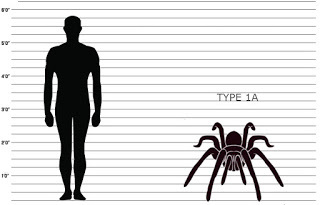 Scale drawing showing a Type 1A spider alongside an average human (© Sgt S)
Scale drawing showing a Type 1A spider alongside an average human (© Sgt S)
----
Animal Type 2A
When everyone calmed down from all the excitement I headed back to my cot. SGT Becky returned from the Aid station under assistance as they had given her tranquilizers. She was removed from training the next day under a command referral due to her traumatized state. My tent mates began complaining about the musty smell on me, so I threw the scent-marked uniform in a laundry bag outside, next to the tent about 20 feet from the door. After I changed and made a coffee I started heading out to the showers and laundry, and stood just inside of the door frame, getting my eyes adjusted to the dark. I had a black shaving kit/ toiletry bag in my right hand outside the open door when I felt something hit the bag. There was a whitish, silver-dollar-sized material connected to a thick string against my black bag. As I turned it slightly to look, it was pulled away from me suddenly and with great force, smashing my wrist into the metal frame of the door and snatching it out of my hand. Just then another soldier leaving the portable toilets, about 40 feet perpendicular to the door, started gasping in silent screams, pointing at a dark mass, about the size of a man and low to the ground along the outer wall of the tent, where my laundry bag was (this [creature] I will label as Type 2A). He threw a plastic spit bottle at the shape on the ground, splashing tobacco spit all over Type 2A, and it turned in his direction making a hissing sound. Immediately I threw my hot coffee and canteen cup that I had in my other hand. Type 2A turned again now with its back to me and raised with its head topping off at about five feet from the ground. Its 2- to 3-inch-thick front and side legs then spread out, shaking menacingly in the air, spanning 6 or 7 feet in circumference! Type 2A's back legs were dangling straight down like it was on its tiptoes and its abdomen was about 1 foot thick by 3 feet long. All this happened instantaneously, and in a split second, it leaped 50 or 60 feet horizontally away! (I suppose it could have run on its back legs but it covered 50 to 60 feet of distance in a split second!) It reached the edge of the "200 man" tent and without stopping it rounded the corner, crashing into another tent alongside ours. It clumsily clambered over the next tent ripping holes in the fabric then disappeared into the woods. Animal Type 2A was much darker in color, with a thicker coat of bristles, much thicker in body mass. Its abdomen was more elongated than bulbous, and its overall size was greater than a large man. I did not see its fangs as it was dark and quickly turned its back to me, but overall, it gave the appearance of an enormous tarantula. Someone found my bag the next day by the wood line and it was punctured, with the shaving cream can exploded and the other contents mangled. Again, the senior officers collected it and ordered us not to talk about the incident. The soldier who threw the spit bottle already had a phobia of spiders and this event so traumatized him that he could no longer speak intelligibly. He became so uncontrollably stressed that he was also removed from the training under command referral.
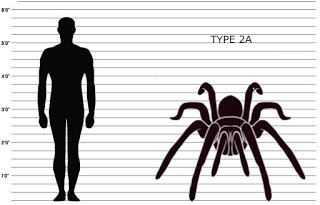 Scale drawing showing a Type 2A spider alongside an average human (© Sgt S)
Scale drawing showing a Type 2A spider alongside an average human (© Sgt S)
In my first email to you on the 2005 event, I mentioned another soldier woke up to what he said looked like a bearded old man wearing large black goggles, looking at us at the base of our open tent door. To elaborate further on that event, that night of the first sighting I placed Army issue cots upright, lengthwise around my sleeping cot in a feeble attempt to protect myself with a wall around me. In the night I awoke to a loud metal banging sound at the rear tent door near where I was sleeping. But when several of us got up there was nothing to see. In the morning one of my upright cots was gone. I found it crumpled up in the field behind our tent with more sticky silk around it. I assume one of the spiders returned and spit silk at where their scent was coming from, catching an upended cot instead of me. The cots are made of sturdy aluminum intended for years of military use and not easily crumpled up by human hands.
After these incidents, the senior leadership came back and ordered me to surrender my boots and any clothing I wore when I was sprayed by Type 1A. I washed my equipment including my helmet, flashlight, and weapon with the Army-issued M295 Decontamination Kit (this is a charcoal powdered mitten that has a disgusting rotten fish oil smell). I also used the M295 kit on my head, face, neck, hands, and arms. I repeated this process a few times to get the smell off me and we sprayed the area down with Army issued STB, or super tropical bleach, (the M295 and STB are for chemical weapons defense). After the decontamination, a few showers, new uniforms, spraying down the tent area with STB, and pouring STB into the hole where Type 1A appeared, the creatures did not return. I was quietly praised for being a survivor and openly mocked for seeing something that was not there or feeling stressed about an event that never happened.
2007 Sighting
Animals Type 1B & Type 2B
I would like to label the 2007 daytime sighting of the large, light-colored trapdoor spider, Type 1B, and the night-time sighting of the gargantuan spider on the roof as Type 2B. [see Part 2 of my previous article here for details of Sgt S's 2007 sighting.]
OBSERVATIONS
1. Nocturnal, occasionally diurnal.
2. Burrowing and tunneling.
3. Creates Trap Doors with silk feeder lines to capture and ambush prey. Alerted by vibrations.
4. Large venomous fangs, and potentially venomous tailhook/ stinger.
5. Spitting silk to capture prey from at least a 20’ distance.
6. Makes a hissing sound when agitated.
7. Urticating hairs with a neurotoxic effect.
8. Raises up and rattles its forelegs legs before jumping horizontally at high velocity to 50 or 60 feet.
9. Pheromone marking and hunting.
10. Inferior sight.
11. Superior olfactory senses.
12. Prey baiting.
13. Easily startled.
14. Returns to scent marked hunting of prey even when startled.
15. Follows scent marked prey over many miles and many days.
16. Moves silently under cover of darkness.
17. "Bags" prey in silk to carry off to burrows.
 Scale drawing showing a Type 1B spider alongside an average human (© Sgt S)
Scale drawing showing a Type 1B spider alongside an average human (© Sgt S)
ASSUMPTIONS:
1. I assume the creatures were hunting after the scent marked on my clothes and body by Type 1A and Type 1B. I propose They may work communally or competitively going after each other’s scent marked prey.
2. Type 2A spit a sticky web hitting my bag and pulled it away from me, perhaps as a way of capturing prey from a distance, like the spitting spider, Scytodes thoracica.
3. I think it reacted to the liquids thrown at it like many common spiders do, by raising up and jumping away, albeit with extraordinarily terrifying force and speed. If I were in its path it would have undoubtedly taken me with it.
4. Animal Types 1A, 1B, 2A, and 2B may all be the same species but different sex and at different life phases. I believe the lighter colored, smaller Types 1A and 1B are the males, as both male spiders are usually smaller, and each performed the scent-marking behavior. I believe Type 2A and Type 2B are the females. Both being larger, darker colored and followed the scent of Types 1A and 1B. One theory is that these are four different animals at two different life stages. Another could be that these are two animals that have enlarged from 2005 to 2007. These could be mated pairs.
5. I speculate that these things may have a long lifespan where they hibernate or have years of inactivity where they remain in their tunnels.
Sgt S concluded his testimony with the following telling comment contained in an email to me of 26 March 2021:
Putting together the scale drawings made me sick with anxiety. I feel nauseous just looking at them again. If I did not see it with my own eyes I wouldn't believe that venomous spiders as large as grizzly bears could actually be roaming around freely in the Louisiana woodlands. I don't care if anyone else believes it to be honest because gravity doesn't care if you believe in it either. Go ahead and jump off a tall building and try not to believe in gravity if you want.
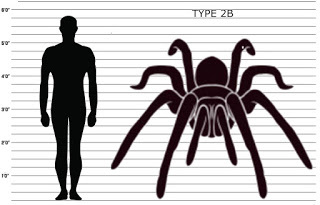 Scale drawing showing a Type 2B spider alongside an average human (© Sgt S)
Scale drawing showing a Type 2B spider alongside an average human (© Sgt S)
So there we have it, make of it all what we will, but undeniably fascinating.
I have already stated my personal opinion as a zoologist regarding the biological feasibility of such spiders, based upon what is currently known concerning arachnid anatomy and physiology. As for whether the U.S. Army would – or could – keep such extraordinary events a secret or alternatively endeavour to seek out and either capture or destroy anything as inimical as these arachnid entities, I am not a military man, so I have neither the theoretical knowledge nor the practical experience to answer such questions. Nor do I have any means of either confirming or discounting Sgt S's testimony. Like so much evidence put forward in cryptozoology, it is entirely anecdotal, unsupported by any physical, tangible evidence. Nevertheless, in view of its detail and depth, I have decided to document it herewith, because I feel not to do so would be both judgmental and remiss, and might even mean that if there is other, independent evidence out there that could substantiate its claim, it might not be brought forward. But now it might, so now we must wait and see.
My sincere thanks to Sgt S for sharing his testimony with me and, as before, for most kindly permitting me to make it publicly available.
For further details concerning giant spider reports, be sure to click here to read a detailed survey on ShukerNature, and also check out the comprehensive chapter devoted to such creatures in my book Mirabilis: A Carnival of Cryptozoology and Unnatural History.
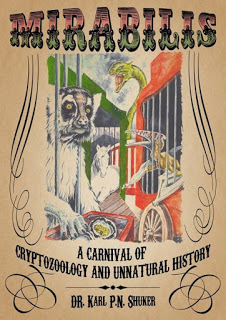
March 30, 2021
SINGING THE PRAISES OF OUR NATIONS' FEATHERED AMBASSADORS
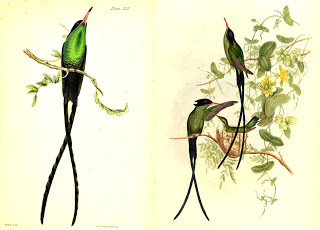 A male doctor bird, Jamaica's national bird, in Philip Henry Gosse's book The Birds of Jamaica, 1849 (public domain) / Doctor birds (two males, one female), in John Gould's tome A Monograph of the Trochilidae, or Family of Humming-birds, Vol. 2, 1861 (public domain)
A male doctor bird, Jamaica's national bird, in Philip Henry Gosse's book The Birds of Jamaica, 1849 (public domain) / Doctor birds (two males, one female), in John Gould's tome A Monograph of the Trochilidae, or Family of Humming-birds, Vol. 2, 1861 (public domain) Despite being a nation intimately associated with birdwatching and a love of all things ornithological in general, the United Kingdom, most surprisingly, is one of the very few nations on Earth that does not have an official national bird. True, several years ago a countrywide poll was held to decide which species should serve as our own representative, and revealed as its winner the robin Erithacus rubecula– a friendly, familiar species beloved of gardeners and Christmas card illustrators, and which has traditionally if unofficially occupied that very same role for untold years anyway. However, even this newsworthy poll failed to convince the powers-that-be to elect the robin formally as our nation's feathered ambassador, and so, at least for now, the wait continues. Elsewhere around the world, conversely, is a vast array of national birds, chosen for many different reasons as their respective country's much-loved avian symbol – from its links to its country's beliefs or culture, or as an eyecatching example of its rich biodiversity, to the longstanding admiration that it has inspired among those people sharing its homeland, or even as a means of highlighting its modern-day rarity and need for conservation. So here, to demonstrate this eclectic variety, is a global twitching tour, highlighting some of the most distinctive national birds with fascinating facts explaining why they are so memorable.
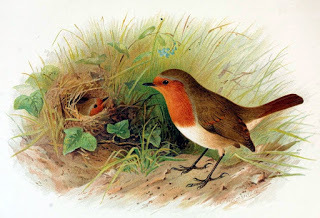 European robin, painted by Frederick W Frohawk, 1907 (public domain)
European robin, painted by Frederick W Frohawk, 1907 (public domain)
Birds of prey have always been greatly admired as symbols of power, strength, intelligence, wisdom, and keen vision, so it is hardly surprising that they have also been popular choices as national birds. Perhaps the most famous example in this capacity is the bald eagle Haliaeetus leucocephalus, the national bird of the USA. One of the world's several species of fish-eating eagle, and named after the adult bird's characteristic white-plumed head (it is brown in juveniles), the bald eagle was officially adopted as the USA's feathered representative on 20 June 1782, when the design of the Great Seal of the United States portraying a bald eagle grasping in its talons 13 arrows representing the 13 founding states plus an olive branch signifying peace was formally adopted by the Continental (Philadelphia) Congress, containing delegates from those states.
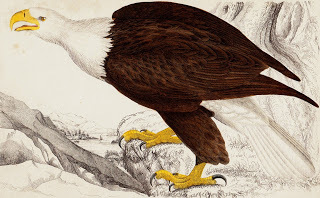 Bald eagle, hand-coloured engraving, 1840 (public domain)
Bald eagle, hand-coloured engraving, 1840 (public domain)
Another country with a tradition of eagle imagery is Germany, and it too has an eagle as its generally-recognised national bird, but this time the golden eagle Aquila chrysaetos. Indeed, the magnificent plumage and stately poise of this species is so imposing that several other countries have also adopted it in this role, including Afghanistan, Armenia, Egypt, Mexico, and Scotland, although in Egypt and Scotland it is presently still in an unofficial capacity, rather like our robin. Moreover, the African fish eagle Haliaeetus vocifer, a close Old World relative of the bald eagle and sporting a very striking brown and white plumage, is so well-regarded on its native African continent that it is the official national bird of no fewer than four different nations – Namibia, South Sudan, Zambia, and Zimbabwe.
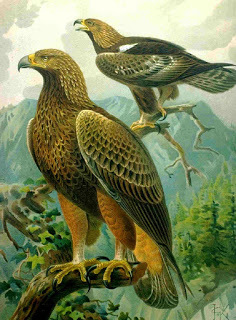 Golden eagles (
Wikipedi
a
– public domain)
Golden eagles (
Wikipedi
a
– public domain)
One of the most spectacular yet also one of the rarest of all eagles is the Philippine eagle Pithecophaga jefferyi. Originally dubbed the monkey-eating eagle as it is large and powerful enough to prey upon sizeable monkeys here, it was subsequently renamed the Philippine eagle and formally installed as its country's national bird on 4 July 1995 by the then president Fidel V. Vamos. This was done in a bid to raise awareness regarding its critically endangered status, a result of longstanding habitat destruction, especially via widespread deforestation. Less than 1,000 individuals are currently thought to exist.
 Philippine eagle, by Henrik Grönvold, 1910 (public domain)
Philippine eagle, by Henrik Grönvold, 1910 (public domain)
Other powerful birds of prey declared as national birds include the harpy eagle Harpia harpyja in Panama, the white-tailed sea eagle or erne Haliaeetus albicilla (Poland), and the gyrfalcon Falco rusticolus (Iceland). Vultures may not seem the most photogenic or behaviourally refined of species to serve as national birds, yet they too clearly have their supporters, because the griffon vulture Gyps fulvus is the national bird of Serbia, and the mighty-pinioned Andean condor Vultur gryphus serves in this role for a quartet of major South American nations (Bolivia, Chile, Colombia, and Ecuador). Smaller raptorial species are not overlooked either, with the peregrine Falco peregrinus representing Angola and the United Arab Emirates, the European kestrel F. tinnunculus Belgium, and the saker falcon F. cherrug Hungary and Mongolia.
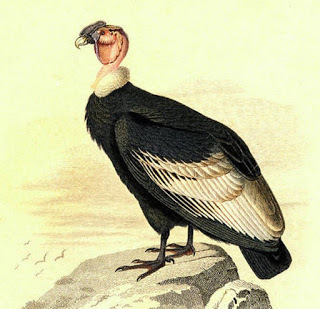 Andean condor, 1800s engraving (public domain)
Andean condor, 1800s engraving (public domain)
As for owls, back in classical times the little owl Athene noctua was the sacred bird of Athena, the Greek goddess of wisdom, so in modern-day times it is the national bird of Greece. And the Aruba burrowing owl A. cunicularia arubensis represents the Caribbean island of Aruba. Perhaps the strangest of all birds of prey is the secretary bird Sagittarius serpentarius, named after its straggly crest that has been fancifully likened to an untidy sheaf of quills that a secretary from bygone times might have placed behind one of his ears. This bizarre-looking species somewhat incongruously combines a hawk-like body with the lengthy legs of a stork, and is famed for its snake-killing abilities in its native Sudan where it is commemorated as that country's national bird.
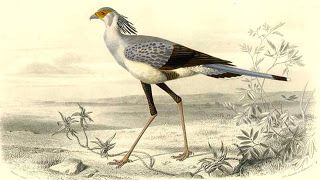 19th-Century painting of a secretary bird, from Dictionnaire Histoire Naturelle by Charles Orbigny (public domain)
19th-Century painting of a secretary bird, from Dictionnaire Histoire Naturelle by Charles Orbigny (public domain)
Waterbirds are another popular choice for national birds. The mute swan Cygnus olorrepresents Denmark, and the whooper swan C. cygnus Finland, whereas more colourful feathered symbols include the American flamingo Phoenicopterus ruber for the Bahamas, the scarlet ibis Eudocimus ruber for Trinidad and Tobago, and the magnificent frigate bird Fregata magnificens (noted for the breeding male's vivid scarlet, greatly-inflatable throat pouch) for not only the Pacific island nation of Kiribati but also the twin-island Caribbean nation of Antigua and Barbuda. Its smaller but no less distinctive relative the great frigate bird F. minor does the honours for Nauru, and on account of their extraordinarily prehistoric appearance when seen high overhead in flight, frigate birds are regularly mistaken by unknowledgeable observers for living pterodactyls!
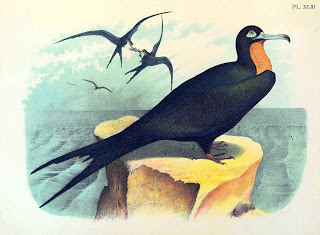 Adult male magnificent frigate bird, painting from The Birds of North America, 1903 (public domain)
Adult male magnificent frigate bird, painting from The Birds of North America, 1903 (public domain)
Their impressive, imposing stature and noble mien no doubt explains why cranes and storks also include several national birds among their assemblage. Most celebrated of these is the blue crane Grus paradisea (aka the paradise or Stanley crane), representing South Africa. Its cultural links to this country include a longstanding tradition among the Xhosa people here, whereby the honour bestowed upon a man who had distinguished himself in battle was to be decorated with blue crane plumes placed in his hair by a chief during a special ceremony known as ukundzabela. Other African nations with a crane as their official symbol include Uganda (its national bird is the grey crowned crane Balearica regulorum) and Nigeria (the black crowned crane B. pavonina). The white stork Ciconia ciconia, a species beloved throughout Europe as the traditional bringer of babies according to fairytales and folklore, is the national bird in both Belarus and Lithuania, whereas the hammerhead or hamerkop Scopus umbretta, an odd stork-like but pelican-related species native to much of sub-Saharan Africa and Madagascar, is the national bird of Gambia, and is widely if erroneously claimed to induce lightning. And speaking of pelicans: the brown pelican Pelecanus occidentalis represents the Caribbean nation of St Kitts and Nevis.
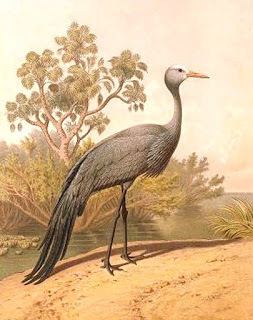 Blue, paradise, or Stanley crane, from A Monograph of the Cranes, 1897, by Frans Ernst Blaauw (public domain)
Blue, paradise, or Stanley crane, from A Monograph of the Cranes, 1897, by Frans Ernst Blaauw (public domain)
Many species of tropical bird have dazzling, multicoloured plumage exhibiting truly extravagant displays of feathered flamboyance, so it is little wonder that some of the most beautiful examples have been adopted by their homelands as national birds. Count Raggi's bird of paradise Paradisaea raggiana, for instance, in which the adult male boasts a fiery explosion of long scarlet plumes with which to tempt and entreat dowdy brown females to mate with him when he dances before them during the breeding season, is the national bird of Papua New Guinea, whose tropical rainforests are home to many of the world's 40-odd bird of paradise species.
 19th-Century painting of an adult male Count Raggi's bird of paradise, by John Gould (public domain)
19th-Century painting of an adult male Count Raggi's bird of paradise, by John Gould (public domain)
Another series of bird species with feathers of the fantastically fabulous kind constitutes the peafowl and pheasants. The blue peacock's famous eye-spotted tail-train when unfurled and held vertically to entice what he hopes are suitably bedazzled peahens is said to owe its distinctive ocellated patterning to the Greek goddess Hera (or Juno in equivalent Roman retellings). Distraught when the messenger god Hermes slew her loyal hundred-eyed watchman Argus at the behest of Zeus, she placed Argus's eyes in the train of the peacock, and adopted it thereafter as her sacred bird. No doubt, therefore, she would be pleased to know that this very familiar species, Pavo cristatus, is honoured as India's national bird. Turning to pheasants, the green pheasant Phasianus versicolor claims comparable prestige in Asia as Japan's national bird, as does the Himalayan monal Lophophorus impejanus for Nepal, the Siamese fireback Lophura diardi for Thailand, and the confusingly-named grey peacock-pheasant Polyplectron bicalcaratum for Myanmar (the last-mentioned species is so-called because although it is a pheasant, it has spotted plumage whose markings recall the ocelli in the peacock's train).
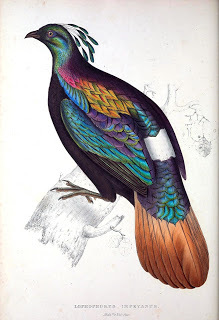 Himalayan monal, from A Century of Birds From the Himalaya Mountains, 1831 (public domain)
Himalayan monal, from A Century of Birds From the Himalaya Mountains, 1831 (public domain)
Parrots were always going to be sought after as national birds by tropical countries fortunate enough to be home to these vividly-plumed perennial favourites among aviculturalists and ornithologists alike, and sure enough, several species have indeed gained that exalted status. The largest, and gaudiest, is undoubtedly the scarlet macaw Ara macao, an animate tricolor of red, blue, and gold, representing Honduras but native to much of northern South America too. Several Caribbean island nations have their very own endemic amazon parrot species – large, brightly-coloured, and found nowhere else – so for reasons of national pride in their avifauna and also to highlight that these species are endangered in many cases, they have duly declared them as their national birds, as with the St Lucia parrot Amazona versicolor for St Lucia, the St Vincent parrot A. guildingii for St Vincent and the Grenadines, and the imperial parrot A. imperialis for Dominica. Nor should we forget the near-threatened Grand Cayman parrot A. leucocephala, the national bird of the Cayman Islands but also found in Cuba and the Bahamas.
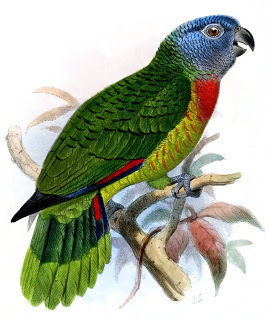 St Lucia parrot, painted by Joseph Smit, Proceedings of the Zoological Society of London, 1875 (public domain)
St Lucia parrot, painted by Joseph Smit, Proceedings of the Zoological Society of London, 1875 (public domain)
The pink-plumaged hoopoe Upupa epops with huge black-and-white wings that bestow upon it the extraordinary guise of a giant butterfly when seen in flight is Israel's national bird, and is intimately linked with biblical lore and legends. According to one such story, hoopoes once bore crests of solid gold, but they were so persecuted by hunters seeking their precious head plumes that they beseeched King Solomon to save them. So in response to their plea, he very kindly transformed their crests into normal feathers, which of course were of no interest to the hunters, and which they have thus borne ever since.
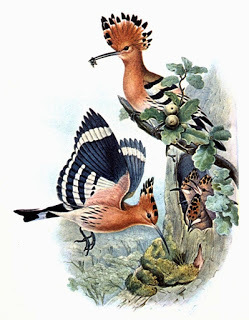 A family of hoopoes, painted by John Gould, 1837 (public domain)
A family of hoopoes, painted by John Gould, 1837 (public domain)
Hoopoes are closely related to kingfishers, rollers, hornbills, and motmots, many of which are brilliantly-plumaged and as a consequence include several national birds among their number, such as the lilac-breasted roller Coracias caudatus for Botswana (and also unofficially for Kenya), the rhinoceros hornbill Buceros rhinoceros for Malaysia, the turquoise-browed motmot Eumomota superciliosa for El Salvador and Nicaragua, and the grey-headed kingfisher Halcyon leucocephala for Cape Verde. Superficially similar to the Old World hornbills due to their comparably top-heavy beaks, but less closely related to them zoologically speaking, are the New World toucans, with the keel-billed toucan Rhamphastos sulfuratus serving Belize as its national bird.
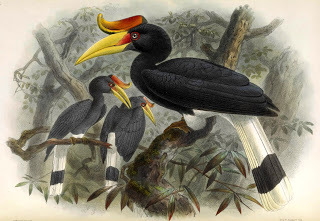 Rhinoceros hornbills, in Daniel Giraud Elliot's A Monograph of the Bucerotidæ, or Family of the Hornbills, 1882 (public domain)
Rhinoceros hornbills, in Daniel Giraud Elliot's A Monograph of the Bucerotidæ, or Family of the Hornbills, 1882 (public domain)
However, the epitome of tropical birds as far as breathtakingly gorgeous plumage is concerned must surely be the trogons. Again distantly related to kingfishers, rollers, and hoopoes, and native to Africa, Asia, and Latin America, these typically thrush-sized birds resemble living jewels when spot-lit by shafts of bright sunlight filtering through the leafy canopy in their jungle domain. Inevitably, therefore, several of them have been adopted as national birds, such as the Hispaniolan trogon Priotelus roseigaster in Haiti, the Cuban trogon P. temnurus in Cuba itself, and the bar-tailed trogon Apaloderma vittatumin Malawi. However, the trogon par excellence – indeed, a leading contender for the world's most beautiful species of bird – is the aptly-named resplendent quetzal Pharomachrus mocinno of Guatemala, whose history, both natural and national, makes fascinating reading.
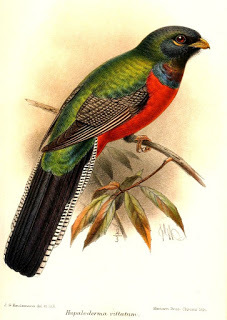 Bar-tailed trogon, by John G. Keulemans, 1892 (public domain)
Bar-tailed trogon, by John G. Keulemans, 1892 (public domain)
According to the ancient traditions of the Aztec nation, which formerly inhabited what is today Mexico (and which in turn formerly included present-day Guatemala within its borders), one of their principal deities, the sky god Quetzalcoatl, would sometimes appear to them in the form of a great airborne feathered serpent with bright emerald-coloured plumes. Today, it is believed that this curious legend arose from real-life observations by the Aztecs of the resplendent quetzal, because during the breeding season the green-plumaged male, which is normally no more than 1 ft long, grows a pair of exceptionally lengthy, elongate tail plumes, also green, but each measuring up to 3 ft long – and when it flies, these two streamer-like feathers extend horizontally behind it and undulate, so that it bears more than a passing resemblance to an extraordinary plumed snake in flight. Such a famous bird of legend has made an immense cultural impact upon Guatemala, one of several Central American countries where this spectacular bird exists (as well as in present-day Mexico) – so much so, in fact, that not only is it Guatemala's national bird but it has given its name to this country's currency too (100 centavos = 1 quetzal since the year 1925), as well as appearing upon both its national flag and its official coat of arms, and also upon its bank notes and many of its postage stamps.
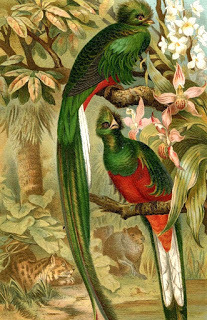 Late 1800s chromolithograph portraying a pair of quetzals (public domain)
Late 1800s chromolithograph portraying a pair of quetzals (public domain)
Also deserving of mention here is a veritable 'quetzal in miniature' that is itself a national bird – the doctor bird Trochilus polytmus, hailing from Jamaica. Indigenous to that island nation, this iridescent green-plumaged hummingbird is characterised by the male's pair of extremely long ribbon-like tail feathers, which make a humming sound as it flies. There is speculation that because these feathers resemble the long silk tail-coats worn by doctors in olden days, this is why the species is called the doctor bird.
Delightful short video of two male doctor birds boldly perching on visitors' fingers as they drink sugar water from bottles (© Conley Salmon/YouTube – inserted here on a strictly non-commercial Fair Use basis for educational/review purposes only)
Of course, not all national birds are chosen for their dramatic appearance or links to mythology. Quite a few have been specifically selected for their basic 'everyman' appeal and popularity, familiar to everyone and loved by all. Italy has as its national bird the Italian sparrow, a cheeky little upstart that is abundant and instantly recognisable everywhere here. Long the subject of controversy as to its precise taxonomic status because it appears intermediate in form between the Spanish sparrow Passer hispaniolensis and the house sparrow P. domesticus, itwas formerly thought to be a hybrid of these two. Nowadays, however, it is often deemed to be a separate, valid species in its own right, albeit one that may indeed have originated via hybridisation between the two afore-mentioned species, and has been dubbed P. italiae, because this is where it predominantly occurs.
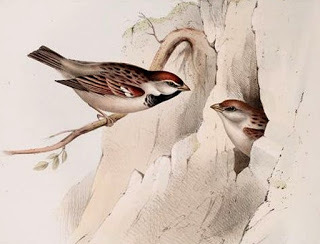 A pair of Italian sparrows, by John Gould, from The Birds of Europe, 1837 (public domain)
A pair of Italian sparrows, by John Gould, from The Birds of Europe, 1837 (public domain)
Other well known but visually modest avian groups with national birds among their membership are the wagtails (the white wagtail Motacilla alba being Latvia's national bird), the crows (Bhutan's is the common raven Corvus corax), swallows (the European or barn swallow Hirundo rustica represents both Austria and Estonia), thrushes (the common blackbird Turdus merula for Sweden, the redwing T. iliacus for Turkey), doves (mourning dove Zenaida macroura for the British Virgin Islands, zenaida dove Z. aurita for Anguilla, Grenada dove Leptotila wellsi for Grenada), and finches (Sinai rosefinch Carpodacus synoicusfor Jordan).
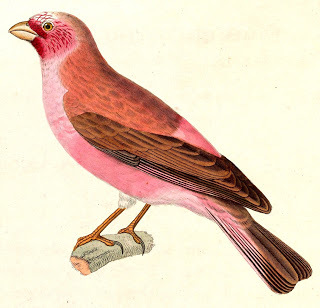 Adult male Sinai rosefinch, painted by Nicolas Huet, 1838 (public domain)
Adult male Sinai rosefinch, painted by Nicolas Huet, 1838 (public domain)
But perhaps the last word on national birds should be reserved for the most poignant example – namely, the species that represents the Mascarene nation of Mauritius in the Indian Ocean. For alone of all such birds, it is no longer in existence, having been slaughtered for its meat more than three centuries ago, only for it afterwards to become an icon in its former island homeland. Today, its instantly recognisable form can be seen everywhere in Mauritius – decorating picture postcards, appearing in advertisements, reproduced as toys of every conceivable composition, and serving as the number one choice for countless visually-inspired souvenirs. And the name of this extinct, exterminated superstar? What else could it be? Raphus cucullatus – the dodo.
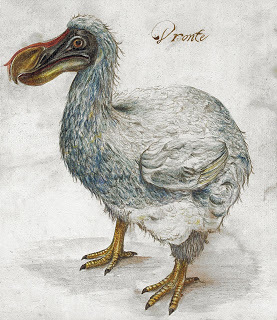 Dodo, 17th-Century Dutch illustration, colour-corrected (public domain)
Dodo, 17th-Century Dutch illustration, colour-corrected (public domain)
March 29, 2021
CENTROPSAR AND SCLATER - THE CAUTIONARY TALE OF A NON-EXISTENT BIRD
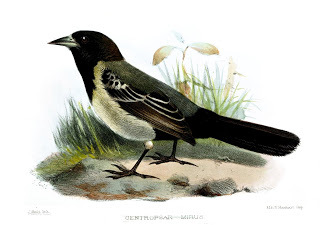 A hand-coloured lithograph from the Proceedings of the Zoological Society of London for 3 March 1874 by Joseph Smit, depicting the likely appearance in life of Centropsar mirus – if it had ever existed, that is… (public domain)
A hand-coloured lithograph from the Proceedings of the Zoological Society of London for 3 March 1874 by Joseph Smit, depicting the likely appearance in life of Centropsar mirus – if it had ever existed, that is… (public domain) During the Victorian era in Britain, Dr Philip Lutley Sclater FRS (1829-1913) was one of the great and the good within the zoological community, having described countless new species (especially birds), and serving for no fewer than 42 years (1860-1902) as Secretary of the pre-eminent Zoological Society of London (ZSL). Yet not even the great and the good are immune from error or misjudgment on occasion, and Sclater was no exception to this merciless rule – as a pretty little bird from Mexico would emphatically demonstrate in 1874.
That was the year when Sclater officially described and named a new species (and genus) of very distinctive passerine (perching bird) on pp. 175-176 in the 3 March issue of the ZSL's Proceedings. He dubbed it Centropsar mirus, and, as was the custom back in those days, listed its diagnostic morphological characteristics in Latin. His account was accompanied by a b/w sketch of the bird's head, wing, and foot (see below), plus the beautiful full-colour plate that opens this present ShukerNature blog article, which had been produced by renowned Dutch zoological artist Joseph Smit and depicted the likely appearance in life of this eye-catching avian novelty.
 The b/w sketch of the head, wing, and foot of C. mirus that was included within Sclater's formal scientific description and naming of this ostensibly new species (public domain)
The b/w sketch of the head, wing, and foot of C. mirus that was included within Sclater's formal scientific description and naming of this ostensibly new species (public domain)
It had been brought to Sclater's attention by much-travelled English ornithologist and zoological specimen collector Edward Bartlett, who had obtained a large collection of bird skins whose species had variously originated from western Mexico and Australia. Based upon the structure of its beak (slender, elongated, tapering to a point) and the specific nature of its short, rounded wings' remiges or flight feathers (the third, fourth, and fifth of its primaries being the longest), Sclater readily recognized that the skin designated by him as the type (and only known) specimen of C. mirus was from an icterid.
Icterids constitute a morphologically diverse taxonomic family of birds wholly endemic to the New World, and include such familiar American species as the bobolink, meadowlarks, red-winged and yellow-headed blackbirds, grackles, cowbirds, Baltimore and other orioles, troupial, and oropendolas (despite their common names, these meadowlarks, blackbirds, and orioles are unrelated to their respective Old World namesakes). Consequently, this meant that the C. mirus specimen must have originated in western Mexico, because there are no icterids of any kind in Australia.
 Dr Philip Lutley Sclater (public domain)
Dr Philip Lutley Sclater (public domain)
Yet although this intriguing bird appeared to be an icterid, when its above-described icterid features were added to its small, weak, slender feet, straight elongated hind claw on each foot, and stiffened retrices (tail feathers) with attrite tips, these characteristics collectively differentiated it from all known icterid genera. This is why Sclater created a brand-new one in order to accommodate it. It is also why he chose mirus – 'wonder' – as its species name, to signify how surprised he had been by this bemusing little bird's unheralded combination of features. So far, so good – until, that is, the newly-described Centropsar mirus came by virtue of Sclater's PZSL account to the attention of a certain Dr Jean Cabanis (1816-1906), who was arguably Germany's foremost ornithological expert at that time.
In 1853, Cabanis had personally founded one of the scientific world's most prestigious periodicals devoted to birds, the Journal für Ornithologie, which he also edited for the next 41 years. Consequently, in 1874, published within Vol. 22, pp. 457-458, of his journal as a succinct but very revealing response to Sclater's earlier pronouncement in the PZSL, Cabanis presented his own opinion regarding Centropsar. Although couched in studiously polite terms, his cloaked comments made uncomfortable reading, especially for Sclater.
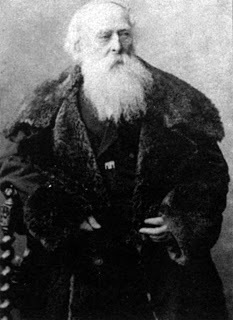 Dr Jean Cabanis (public domain)
Dr Jean Cabanis (public domain)
Translating from the German, Cabanis's non-technical remarks were a triumph of silky suspicion:
Dr. Sclater has chosen the species name mirusvery aptly; that the bird which arouses the most lively interest is in fact "wonderful" and difficult to reconcile with our concepts of "natural" systematics. If it were not brought to science by such an eminently experienced ornithologist as Dr Sclater, one would be entitled to regard it as an artefact. From the description and the illustrations, however, no final judgment could be made, since an error could possibly also have been made.
Ouch!
Cabanis then considered the technical minutiae of its morphology, which evidently and understandably perplexed him, because Centropsar uniquely embodied characteristics drawn from two entirely separate taxonomic groups of bird. Clearly something was drastically amiss here, and Cabanis knew it. Yet as he had not examined this bird personally, he felt unable to say more, but his doubts had been clearly expressed for all to see. He ended his comments with a final, singularly prophetic one: "Surely the wonderful Centropsar will get its natural solution".
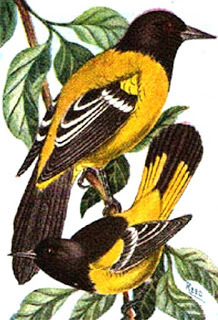 A pair of adult Audubon's orioles – belonging to the New World icterid family, and therefore unrelated to the Old World orioles (public domain)
A pair of adult Audubon's orioles – belonging to the New World icterid family, and therefore unrelated to the Old World orioles (public domain)
It will come as no surprise to learn that once Sclater had read Cabanis's ill-concealed challenge to his identification of the unique, taxonomically impossible Centropsarspecimen, he lost no time in re-examining it, but now in much closer detail, only to uncover the awful if inevitable truth. To his credit, however, Sclater put on a brave face and confessed all at a meeting of the Zoological Society of London shortly afterwards, with his mea culpa duly documented in the 1 June 1874 issue of the PZSL:
Mr. Sclater laid on the table the typical [i.e. type] specimen of his Centropsar mirus (P.Z.S. 1874, p. 176, pl. xxvi.), and made the following remarks:-
"My suspicions having been awakened as to this specimen by information received from Mr. E. Bartlett and by the criticisms of Dr. Cabanis ('Journ. für Orn.' vol. xxii, 1874, p. 458 [although Cabanis's comments actually began on p. 457]), I have made a thorough reexamination of it.
"The result arrived at is that the supposed novelty is undoubtedly composed of parts of three other birds. The head, wings, and body are those of a female or immature Icterus, possibly I. auduboni [Audubon's oriole, nowadays reclassified as a subspecies of the black-headed oriole I. graduacauda], though I have no specimen quite agreeing with it. To this have been added the worn tail of an Agelaeus gubernator [nowadays reclassified as Agelaius phoeniceus gubernator] or A. phoeniceus [the red-winged blackbird], and the legs of an Otocorys [nowadays renamed Eremophila, consisting of two species of Old World horned lark].
"Centropsar mirus may therefore be removed from the ornithological category. Mr. E. Bartlett tells me that there were other fictitious specimens in the same collection."
"Now he tells me!" may well have been the unspoken thought running through Sclater's mind when he uttered that last confessional comment at the ZSL meeting!
 A red-winged blackbird, belonging to the New World icterid family, and therefore unrelated to the Old World blackbirds (public domain)
A red-winged blackbird, belonging to the New World icterid family, and therefore unrelated to the Old World blackbirds (public domain)
So, the wonderful Centropsar had been unmasked not as a wonder at all, but merely as a heterogeneous humbug. It was a feathered Frankensteinian creation subtly stitched together with body parts from two different species of New World icterid plus an alaudid or true lark, i.e. collectively representing two entirely separate taxonomic families!
Yet to be fair, this composite skin must have been prepared with no small amount of skill in order for it to have fooled, at least on first sight, even as immensely experienced an ornithologist as Sclater, so we shouldn't be too hard upon him. He wasn't the first to have been tricked by a fine-feathered fraud, and he certainly won't be the last!
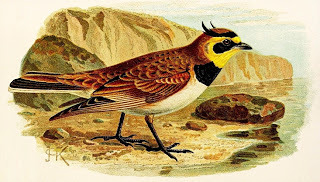 Painted in 1891 by another acclaimed Dutch bird artist John G. Keulemans, and native to much of the northern hemisphere, this is a horned (shore) lark – a species of alaudid or true lark, and therefore unrelated to the icterids (public domain)
Painted in 1891 by another acclaimed Dutch bird artist John G. Keulemans, and native to much of the northern hemisphere, this is a horned (shore) lark – a species of alaudid or true lark, and therefore unrelated to the icterids (public domain)
Karl Shuker's Blog
- Karl Shuker's profile
- 45 followers



